KIT710 eLogistics Assignment 2: Salmon Seafood Supply Chain Strategy
VerifiedAdded on 2022/11/28
|18
|4908
|237
Report
AI Summary
This report provides a comprehensive analysis of the logistics strategy for the salmon seafood supply chain, focusing on the application of eLogistics principles to improve performance. The study begins with an assessment of the current logistics and eLogistics practices in the Australian salmon industry, including an examination of key activities such as ordering, material handling, warehousing, and transportation. The report then delves into the influence of five megatrends—a hungrier world, globalization, climate change, a wealthier world, and transformative technologies—on the supply chain. Furthermore, it explores the application of the 7Rs of eLogistics within the salmon industry and offers recommendations for enhancing quality management, traceability, and overall efficiency. Specific strategies discussed include the implementation of cold chain storage, lean manufacturing, and SAP transportation management to address challenges related to visibility, demand planning, material management, and transportation optimization. The report aims to enhance the quality management of the product in the fresh fish supply chain using the improved logistics management and the guaranteed effectiveness in the traceability.
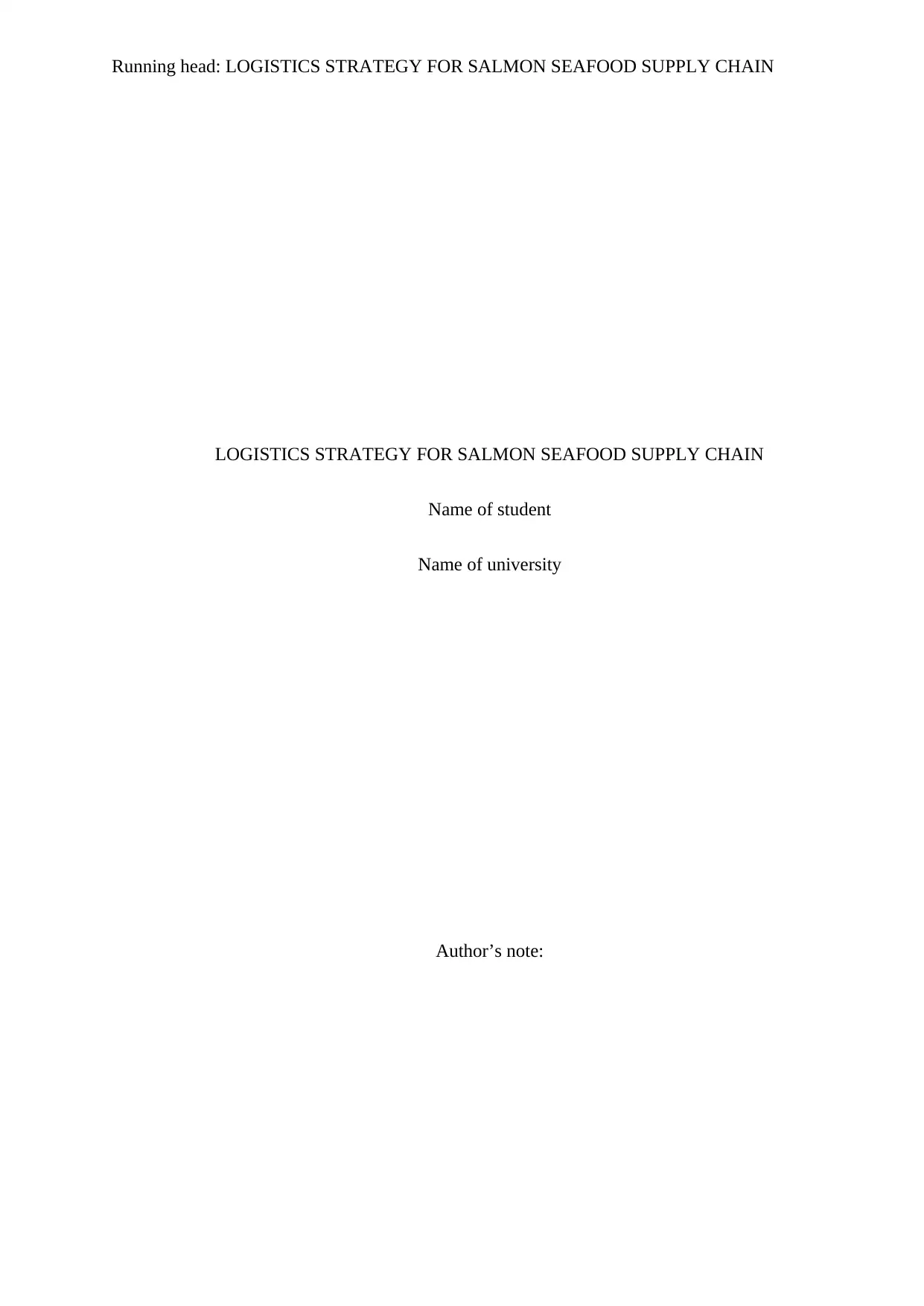
Running head: LOGISTICS STRATEGY FOR SALMON SEAFOOD SUPPLY CHAIN
LOGISTICS STRATEGY FOR SALMON SEAFOOD SUPPLY CHAIN
Name of student
Name of university
Author’s note:
LOGISTICS STRATEGY FOR SALMON SEAFOOD SUPPLY CHAIN
Name of student
Name of university
Author’s note:
Secure Best Marks with AI Grader
Need help grading? Try our AI Grader for instant feedback on your assignments.
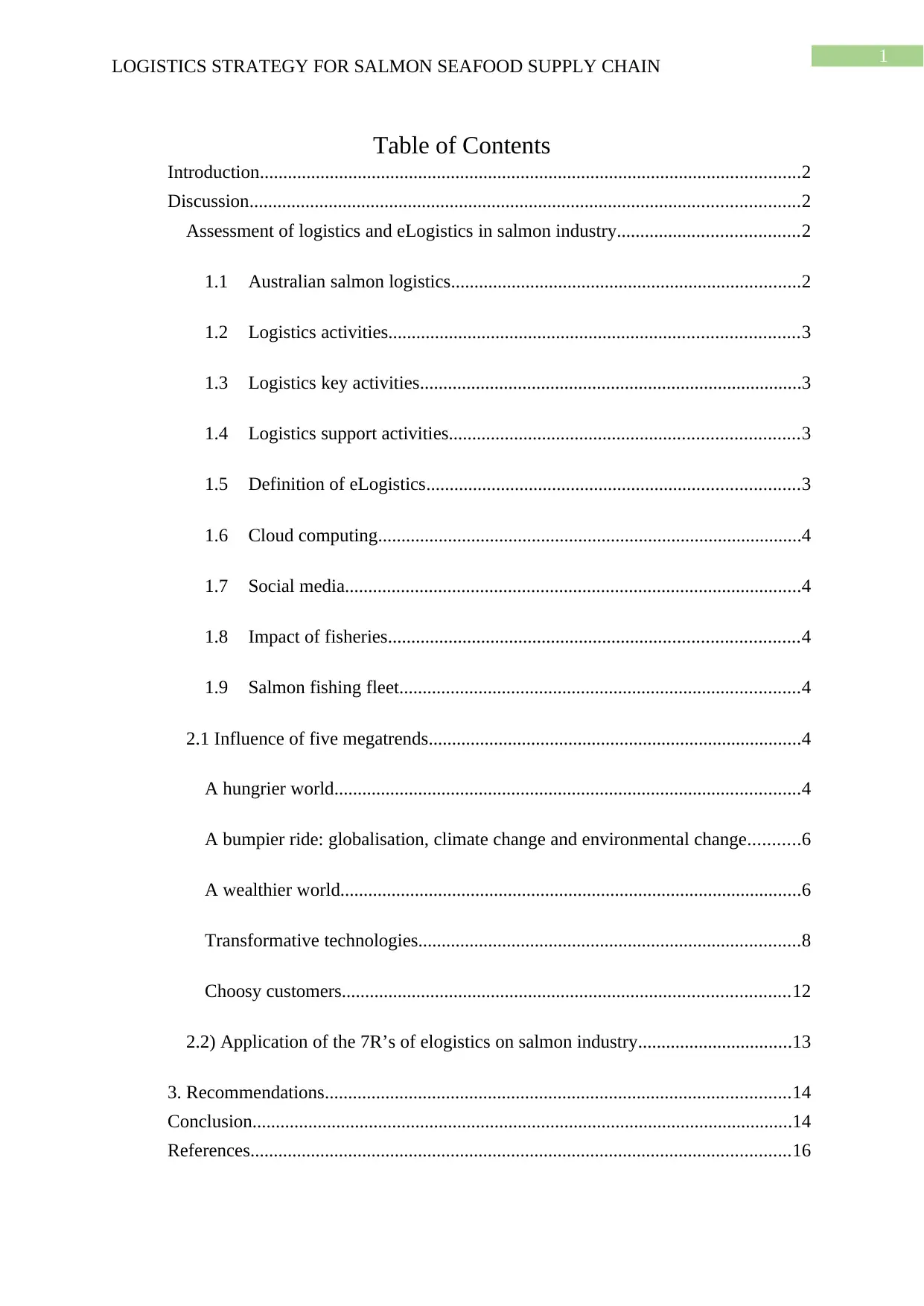
1
LOGISTICS STRATEGY FOR SALMON SEAFOOD SUPPLY CHAIN
Table of Contents
Introduction....................................................................................................................2
Discussion......................................................................................................................2
Assessment of logistics and eLogistics in salmon industry.......................................2
1.1 Australian salmon logistics...........................................................................2
1.2 Logistics activities........................................................................................3
1.3 Logistics key activities..................................................................................3
1.4 Logistics support activities...........................................................................3
1.5 Definition of eLogistics................................................................................3
1.6 Cloud computing...........................................................................................4
1.7 Social media..................................................................................................4
1.8 Impact of fisheries........................................................................................4
1.9 Salmon fishing fleet......................................................................................4
2.1 Influence of five megatrends................................................................................4
A hungrier world....................................................................................................4
A bumpier ride: globalisation, climate change and environmental change...........6
A wealthier world...................................................................................................6
Transformative technologies..................................................................................8
Choosy customers................................................................................................12
2.2) Application of the 7R’s of elogistics on salmon industry.................................13
3. Recommendations....................................................................................................14
Conclusion....................................................................................................................14
References....................................................................................................................16
LOGISTICS STRATEGY FOR SALMON SEAFOOD SUPPLY CHAIN
Table of Contents
Introduction....................................................................................................................2
Discussion......................................................................................................................2
Assessment of logistics and eLogistics in salmon industry.......................................2
1.1 Australian salmon logistics...........................................................................2
1.2 Logistics activities........................................................................................3
1.3 Logistics key activities..................................................................................3
1.4 Logistics support activities...........................................................................3
1.5 Definition of eLogistics................................................................................3
1.6 Cloud computing...........................................................................................4
1.7 Social media..................................................................................................4
1.8 Impact of fisheries........................................................................................4
1.9 Salmon fishing fleet......................................................................................4
2.1 Influence of five megatrends................................................................................4
A hungrier world....................................................................................................4
A bumpier ride: globalisation, climate change and environmental change...........6
A wealthier world...................................................................................................6
Transformative technologies..................................................................................8
Choosy customers................................................................................................12
2.2) Application of the 7R’s of elogistics on salmon industry.................................13
3. Recommendations....................................................................................................14
Conclusion....................................................................................................................14
References....................................................................................................................16
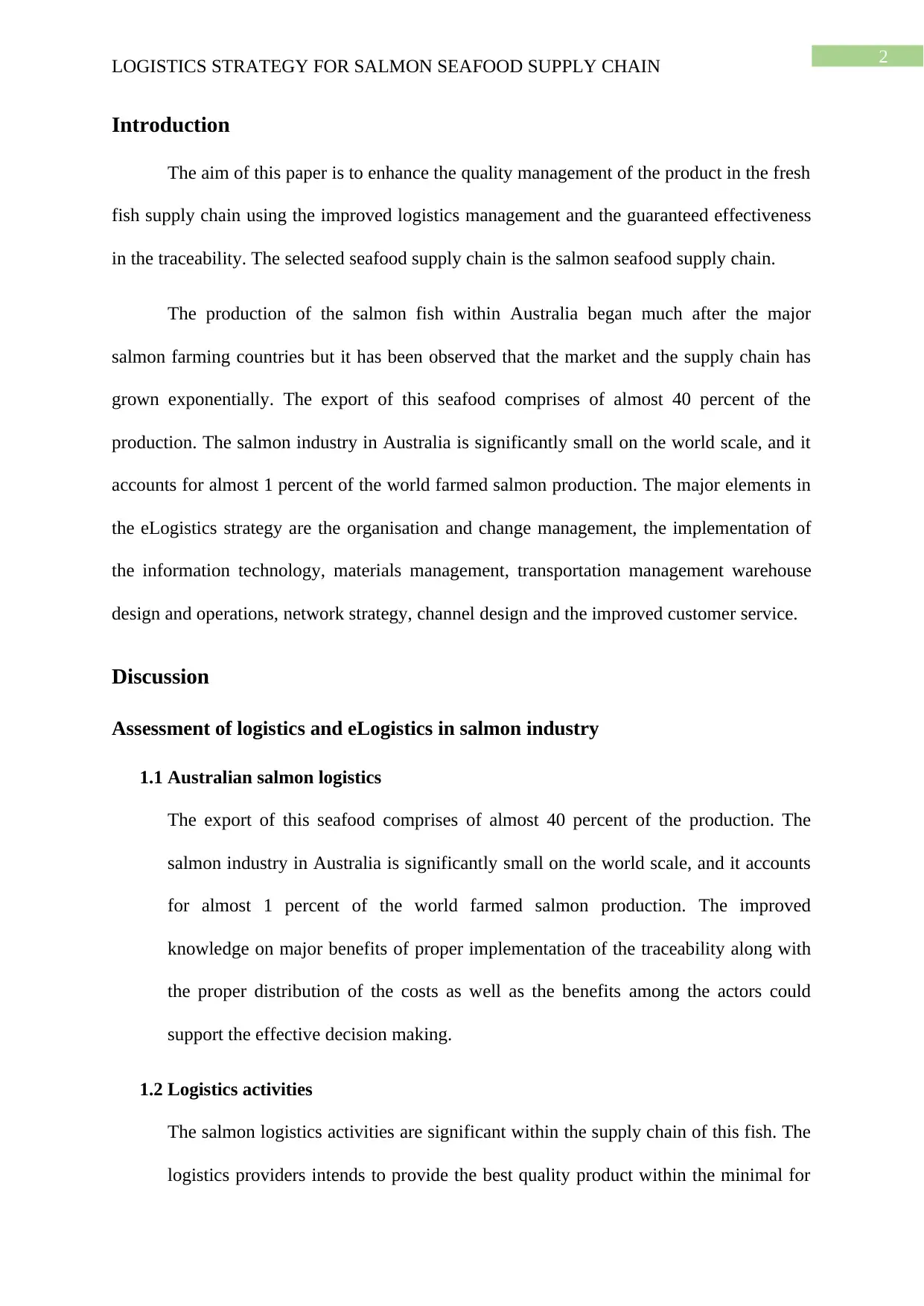
2
LOGISTICS STRATEGY FOR SALMON SEAFOOD SUPPLY CHAIN
Introduction
The aim of this paper is to enhance the quality management of the product in the fresh
fish supply chain using the improved logistics management and the guaranteed effectiveness
in the traceability. The selected seafood supply chain is the salmon seafood supply chain.
The production of the salmon fish within Australia began much after the major
salmon farming countries but it has been observed that the market and the supply chain has
grown exponentially. The export of this seafood comprises of almost 40 percent of the
production. The salmon industry in Australia is significantly small on the world scale, and it
accounts for almost 1 percent of the world farmed salmon production. The major elements in
the eLogistics strategy are the organisation and change management, the implementation of
the information technology, materials management, transportation management warehouse
design and operations, network strategy, channel design and the improved customer service.
Discussion
Assessment of logistics and eLogistics in salmon industry
1.1 Australian salmon logistics
The export of this seafood comprises of almost 40 percent of the production. The
salmon industry in Australia is significantly small on the world scale, and it accounts
for almost 1 percent of the world farmed salmon production. The improved
knowledge on major benefits of proper implementation of the traceability along with
the proper distribution of the costs as well as the benefits among the actors could
support the effective decision making.
1.2 Logistics activities
The salmon logistics activities are significant within the supply chain of this fish. The
logistics providers intends to provide the best quality product within the minimal for
LOGISTICS STRATEGY FOR SALMON SEAFOOD SUPPLY CHAIN
Introduction
The aim of this paper is to enhance the quality management of the product in the fresh
fish supply chain using the improved logistics management and the guaranteed effectiveness
in the traceability. The selected seafood supply chain is the salmon seafood supply chain.
The production of the salmon fish within Australia began much after the major
salmon farming countries but it has been observed that the market and the supply chain has
grown exponentially. The export of this seafood comprises of almost 40 percent of the
production. The salmon industry in Australia is significantly small on the world scale, and it
accounts for almost 1 percent of the world farmed salmon production. The major elements in
the eLogistics strategy are the organisation and change management, the implementation of
the information technology, materials management, transportation management warehouse
design and operations, network strategy, channel design and the improved customer service.
Discussion
Assessment of logistics and eLogistics in salmon industry
1.1 Australian salmon logistics
The export of this seafood comprises of almost 40 percent of the production. The
salmon industry in Australia is significantly small on the world scale, and it accounts
for almost 1 percent of the world farmed salmon production. The improved
knowledge on major benefits of proper implementation of the traceability along with
the proper distribution of the costs as well as the benefits among the actors could
support the effective decision making.
1.2 Logistics activities
The salmon logistics activities are significant within the supply chain of this fish. The
logistics providers intends to provide the best quality product within the minimal for
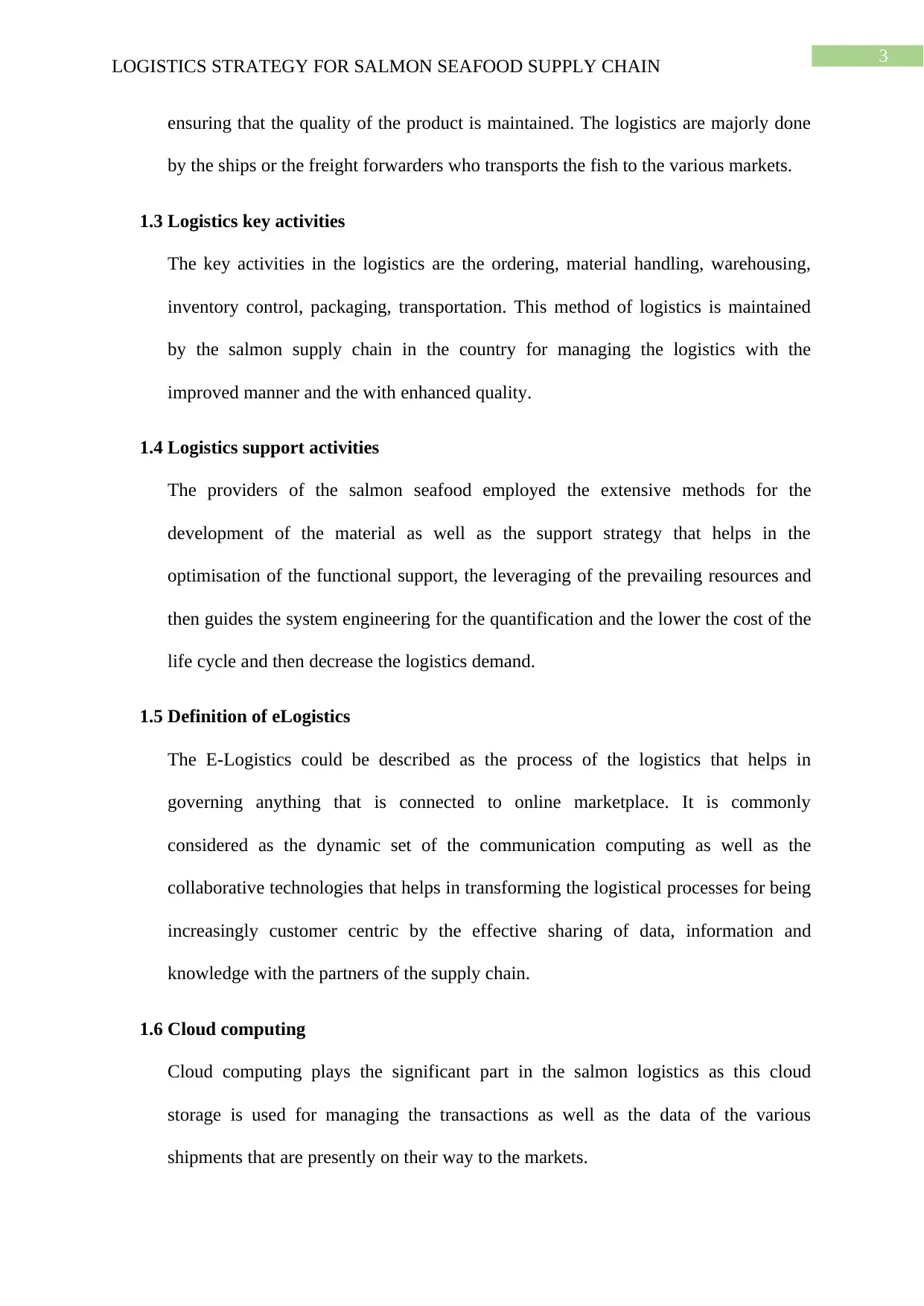
3
LOGISTICS STRATEGY FOR SALMON SEAFOOD SUPPLY CHAIN
ensuring that the quality of the product is maintained. The logistics are majorly done
by the ships or the freight forwarders who transports the fish to the various markets.
1.3 Logistics key activities
The key activities in the logistics are the ordering, material handling, warehousing,
inventory control, packaging, transportation. This method of logistics is maintained
by the salmon supply chain in the country for managing the logistics with the
improved manner and the with enhanced quality.
1.4 Logistics support activities
The providers of the salmon seafood employed the extensive methods for the
development of the material as well as the support strategy that helps in the
optimisation of the functional support, the leveraging of the prevailing resources and
then guides the system engineering for the quantification and the lower the cost of the
life cycle and then decrease the logistics demand.
1.5 Definition of eLogistics
The E-Logistics could be described as the process of the logistics that helps in
governing anything that is connected to online marketplace. It is commonly
considered as the dynamic set of the communication computing as well as the
collaborative technologies that helps in transforming the logistical processes for being
increasingly customer centric by the effective sharing of data, information and
knowledge with the partners of the supply chain.
1.6 Cloud computing
Cloud computing plays the significant part in the salmon logistics as this cloud
storage is used for managing the transactions as well as the data of the various
shipments that are presently on their way to the markets.
LOGISTICS STRATEGY FOR SALMON SEAFOOD SUPPLY CHAIN
ensuring that the quality of the product is maintained. The logistics are majorly done
by the ships or the freight forwarders who transports the fish to the various markets.
1.3 Logistics key activities
The key activities in the logistics are the ordering, material handling, warehousing,
inventory control, packaging, transportation. This method of logistics is maintained
by the salmon supply chain in the country for managing the logistics with the
improved manner and the with enhanced quality.
1.4 Logistics support activities
The providers of the salmon seafood employed the extensive methods for the
development of the material as well as the support strategy that helps in the
optimisation of the functional support, the leveraging of the prevailing resources and
then guides the system engineering for the quantification and the lower the cost of the
life cycle and then decrease the logistics demand.
1.5 Definition of eLogistics
The E-Logistics could be described as the process of the logistics that helps in
governing anything that is connected to online marketplace. It is commonly
considered as the dynamic set of the communication computing as well as the
collaborative technologies that helps in transforming the logistical processes for being
increasingly customer centric by the effective sharing of data, information and
knowledge with the partners of the supply chain.
1.6 Cloud computing
Cloud computing plays the significant part in the salmon logistics as this cloud
storage is used for managing the transactions as well as the data of the various
shipments that are presently on their way to the markets.
Secure Best Marks with AI Grader
Need help grading? Try our AI Grader for instant feedback on your assignments.
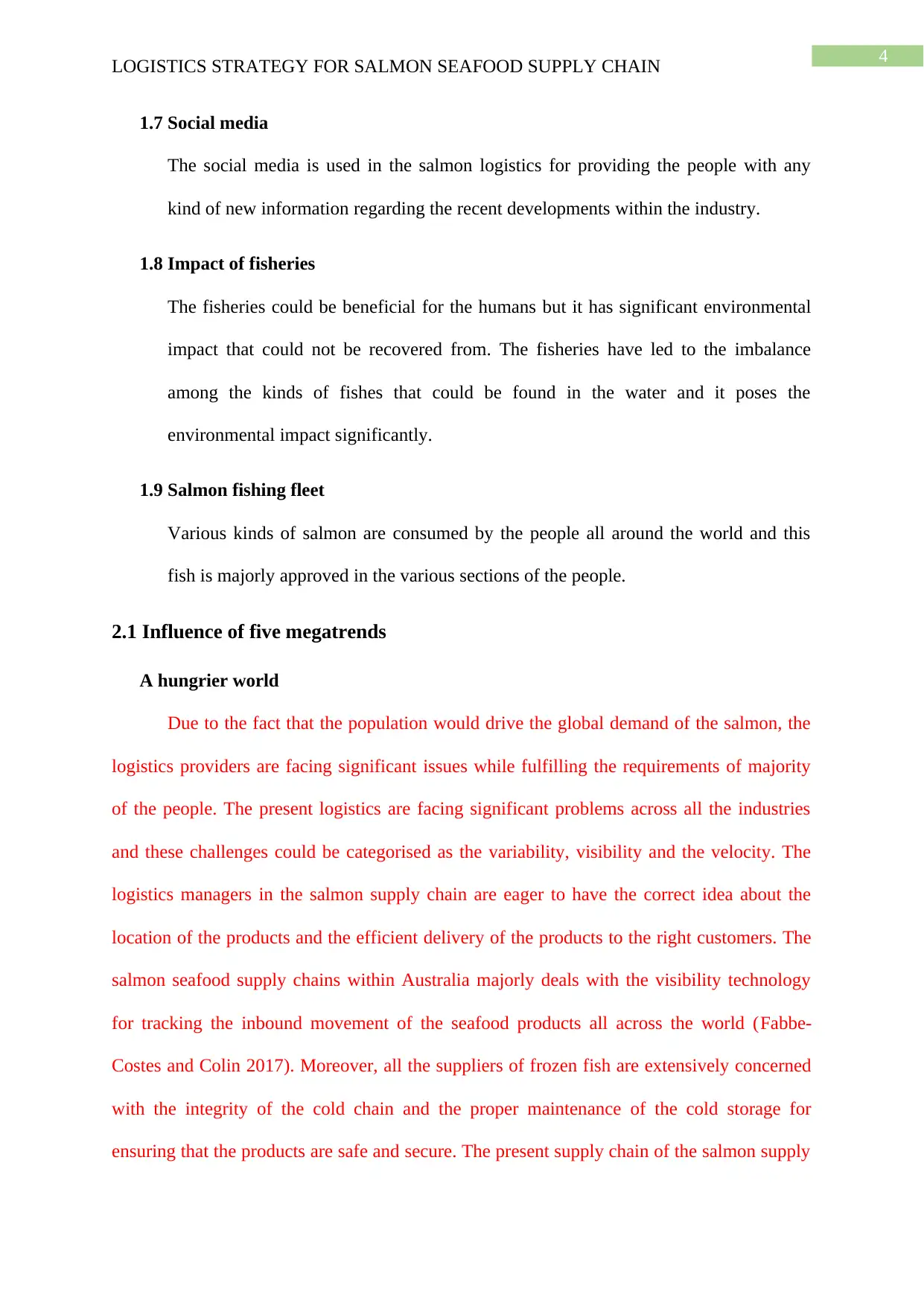
4
LOGISTICS STRATEGY FOR SALMON SEAFOOD SUPPLY CHAIN
1.7 Social media
The social media is used in the salmon logistics for providing the people with any
kind of new information regarding the recent developments within the industry.
1.8 Impact of fisheries
The fisheries could be beneficial for the humans but it has significant environmental
impact that could not be recovered from. The fisheries have led to the imbalance
among the kinds of fishes that could be found in the water and it poses the
environmental impact significantly.
1.9 Salmon fishing fleet
Various kinds of salmon are consumed by the people all around the world and this
fish is majorly approved in the various sections of the people.
2.1 Influence of five megatrends
A hungrier world
Due to the fact that the population would drive the global demand of the salmon, the
logistics providers are facing significant issues while fulfilling the requirements of majority
of the people. The present logistics are facing significant problems across all the industries
and these challenges could be categorised as the variability, visibility and the velocity. The
logistics managers in the salmon supply chain are eager to have the correct idea about the
location of the products and the efficient delivery of the products to the right customers. The
salmon seafood supply chains within Australia majorly deals with the visibility technology
for tracking the inbound movement of the seafood products all across the world (Fabbe-
Costes and Colin 2017). Moreover, all the suppliers of frozen fish are extensively concerned
with the integrity of the cold chain and the proper maintenance of the cold storage for
ensuring that the products are safe and secure. The present supply chain of the salmon supply
LOGISTICS STRATEGY FOR SALMON SEAFOOD SUPPLY CHAIN
1.7 Social media
The social media is used in the salmon logistics for providing the people with any
kind of new information regarding the recent developments within the industry.
1.8 Impact of fisheries
The fisheries could be beneficial for the humans but it has significant environmental
impact that could not be recovered from. The fisheries have led to the imbalance
among the kinds of fishes that could be found in the water and it poses the
environmental impact significantly.
1.9 Salmon fishing fleet
Various kinds of salmon are consumed by the people all around the world and this
fish is majorly approved in the various sections of the people.
2.1 Influence of five megatrends
A hungrier world
Due to the fact that the population would drive the global demand of the salmon, the
logistics providers are facing significant issues while fulfilling the requirements of majority
of the people. The present logistics are facing significant problems across all the industries
and these challenges could be categorised as the variability, visibility and the velocity. The
logistics managers in the salmon supply chain are eager to have the correct idea about the
location of the products and the efficient delivery of the products to the right customers. The
salmon seafood supply chains within Australia majorly deals with the visibility technology
for tracking the inbound movement of the seafood products all across the world (Fabbe-
Costes and Colin 2017). Moreover, all the suppliers of frozen fish are extensively concerned
with the integrity of the cold chain and the proper maintenance of the cold storage for
ensuring that the products are safe and secure. The present supply chain of the salmon supply
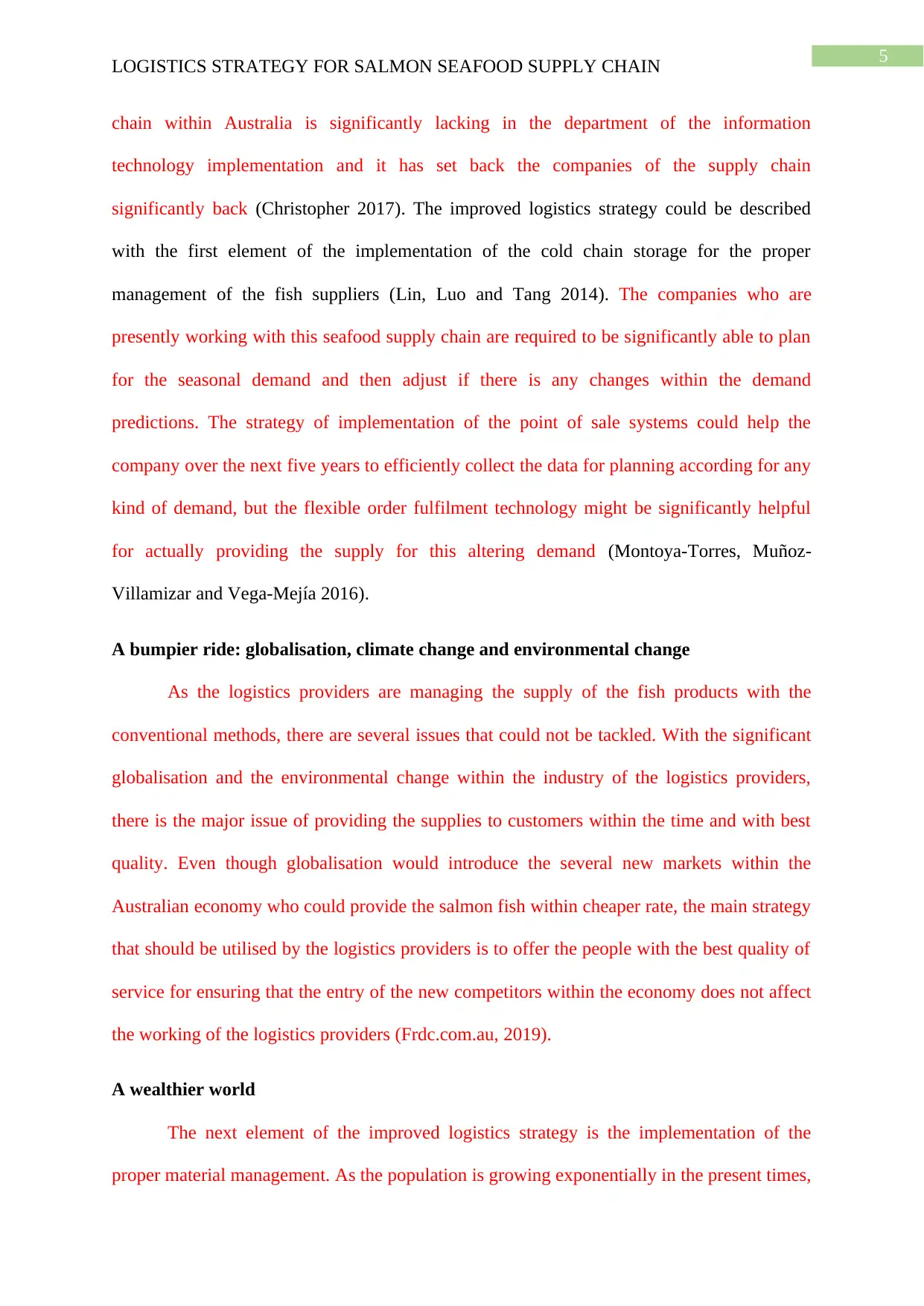
5
LOGISTICS STRATEGY FOR SALMON SEAFOOD SUPPLY CHAIN
chain within Australia is significantly lacking in the department of the information
technology implementation and it has set back the companies of the supply chain
significantly back (Christopher 2017). The improved logistics strategy could be described
with the first element of the implementation of the cold chain storage for the proper
management of the fish suppliers (Lin, Luo and Tang 2014). The companies who are
presently working with this seafood supply chain are required to be significantly able to plan
for the seasonal demand and then adjust if there is any changes within the demand
predictions. The strategy of implementation of the point of sale systems could help the
company over the next five years to efficiently collect the data for planning according for any
kind of demand, but the flexible order fulfilment technology might be significantly helpful
for actually providing the supply for this altering demand (Montoya-Torres, Muñoz-
Villamizar and Vega-Mejía 2016).
A bumpier ride: globalisation, climate change and environmental change
As the logistics providers are managing the supply of the fish products with the
conventional methods, there are several issues that could not be tackled. With the significant
globalisation and the environmental change within the industry of the logistics providers,
there is the major issue of providing the supplies to customers within the time and with best
quality. Even though globalisation would introduce the several new markets within the
Australian economy who could provide the salmon fish within cheaper rate, the main strategy
that should be utilised by the logistics providers is to offer the people with the best quality of
service for ensuring that the entry of the new competitors within the economy does not affect
the working of the logistics providers (Frdc.com.au, 2019).
A wealthier world
The next element of the improved logistics strategy is the implementation of the
proper material management. As the population is growing exponentially in the present times,
LOGISTICS STRATEGY FOR SALMON SEAFOOD SUPPLY CHAIN
chain within Australia is significantly lacking in the department of the information
technology implementation and it has set back the companies of the supply chain
significantly back (Christopher 2017). The improved logistics strategy could be described
with the first element of the implementation of the cold chain storage for the proper
management of the fish suppliers (Lin, Luo and Tang 2014). The companies who are
presently working with this seafood supply chain are required to be significantly able to plan
for the seasonal demand and then adjust if there is any changes within the demand
predictions. The strategy of implementation of the point of sale systems could help the
company over the next five years to efficiently collect the data for planning according for any
kind of demand, but the flexible order fulfilment technology might be significantly helpful
for actually providing the supply for this altering demand (Montoya-Torres, Muñoz-
Villamizar and Vega-Mejía 2016).
A bumpier ride: globalisation, climate change and environmental change
As the logistics providers are managing the supply of the fish products with the
conventional methods, there are several issues that could not be tackled. With the significant
globalisation and the environmental change within the industry of the logistics providers,
there is the major issue of providing the supplies to customers within the time and with best
quality. Even though globalisation would introduce the several new markets within the
Australian economy who could provide the salmon fish within cheaper rate, the main strategy
that should be utilised by the logistics providers is to offer the people with the best quality of
service for ensuring that the entry of the new competitors within the economy does not affect
the working of the logistics providers (Frdc.com.au, 2019).
A wealthier world
The next element of the improved logistics strategy is the implementation of the
proper material management. As the population is growing exponentially in the present times,
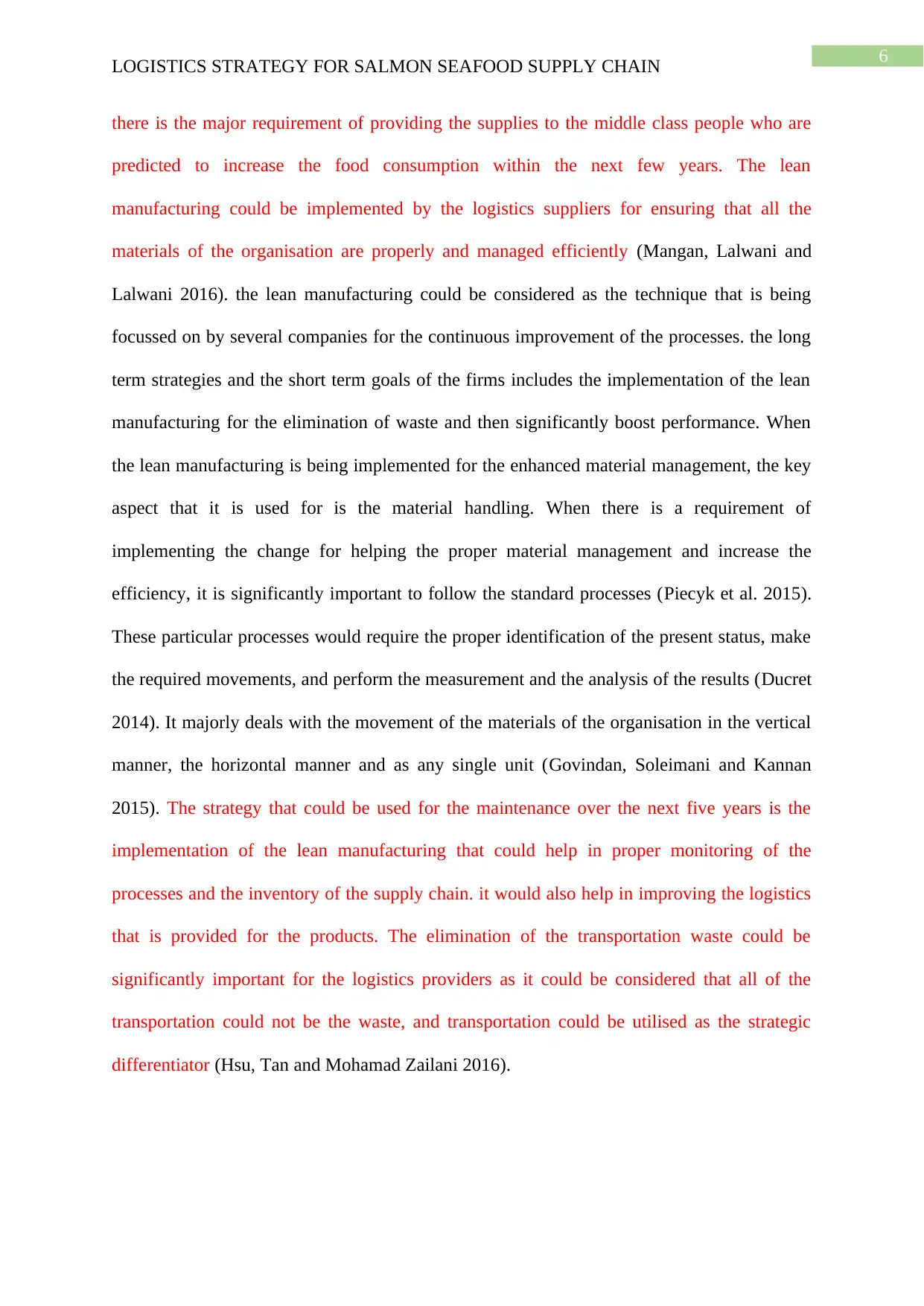
6
LOGISTICS STRATEGY FOR SALMON SEAFOOD SUPPLY CHAIN
there is the major requirement of providing the supplies to the middle class people who are
predicted to increase the food consumption within the next few years. The lean
manufacturing could be implemented by the logistics suppliers for ensuring that all the
materials of the organisation are properly and managed efficiently (Mangan, Lalwani and
Lalwani 2016). the lean manufacturing could be considered as the technique that is being
focussed on by several companies for the continuous improvement of the processes. the long
term strategies and the short term goals of the firms includes the implementation of the lean
manufacturing for the elimination of waste and then significantly boost performance. When
the lean manufacturing is being implemented for the enhanced material management, the key
aspect that it is used for is the material handling. When there is a requirement of
implementing the change for helping the proper material management and increase the
efficiency, it is significantly important to follow the standard processes (Piecyk et al. 2015).
These particular processes would require the proper identification of the present status, make
the required movements, and perform the measurement and the analysis of the results (Ducret
2014). It majorly deals with the movement of the materials of the organisation in the vertical
manner, the horizontal manner and as any single unit (Govindan, Soleimani and Kannan
2015). The strategy that could be used for the maintenance over the next five years is the
implementation of the lean manufacturing that could help in proper monitoring of the
processes and the inventory of the supply chain. it would also help in improving the logistics
that is provided for the products. The elimination of the transportation waste could be
significantly important for the logistics providers as it could be considered that all of the
transportation could not be the waste, and transportation could be utilised as the strategic
differentiator (Hsu, Tan and Mohamad Zailani 2016).
LOGISTICS STRATEGY FOR SALMON SEAFOOD SUPPLY CHAIN
there is the major requirement of providing the supplies to the middle class people who are
predicted to increase the food consumption within the next few years. The lean
manufacturing could be implemented by the logistics suppliers for ensuring that all the
materials of the organisation are properly and managed efficiently (Mangan, Lalwani and
Lalwani 2016). the lean manufacturing could be considered as the technique that is being
focussed on by several companies for the continuous improvement of the processes. the long
term strategies and the short term goals of the firms includes the implementation of the lean
manufacturing for the elimination of waste and then significantly boost performance. When
the lean manufacturing is being implemented for the enhanced material management, the key
aspect that it is used for is the material handling. When there is a requirement of
implementing the change for helping the proper material management and increase the
efficiency, it is significantly important to follow the standard processes (Piecyk et al. 2015).
These particular processes would require the proper identification of the present status, make
the required movements, and perform the measurement and the analysis of the results (Ducret
2014). It majorly deals with the movement of the materials of the organisation in the vertical
manner, the horizontal manner and as any single unit (Govindan, Soleimani and Kannan
2015). The strategy that could be used for the maintenance over the next five years is the
implementation of the lean manufacturing that could help in proper monitoring of the
processes and the inventory of the supply chain. it would also help in improving the logistics
that is provided for the products. The elimination of the transportation waste could be
significantly important for the logistics providers as it could be considered that all of the
transportation could not be the waste, and transportation could be utilised as the strategic
differentiator (Hsu, Tan and Mohamad Zailani 2016).
Paraphrase This Document
Need a fresh take? Get an instant paraphrase of this document with our AI Paraphraser
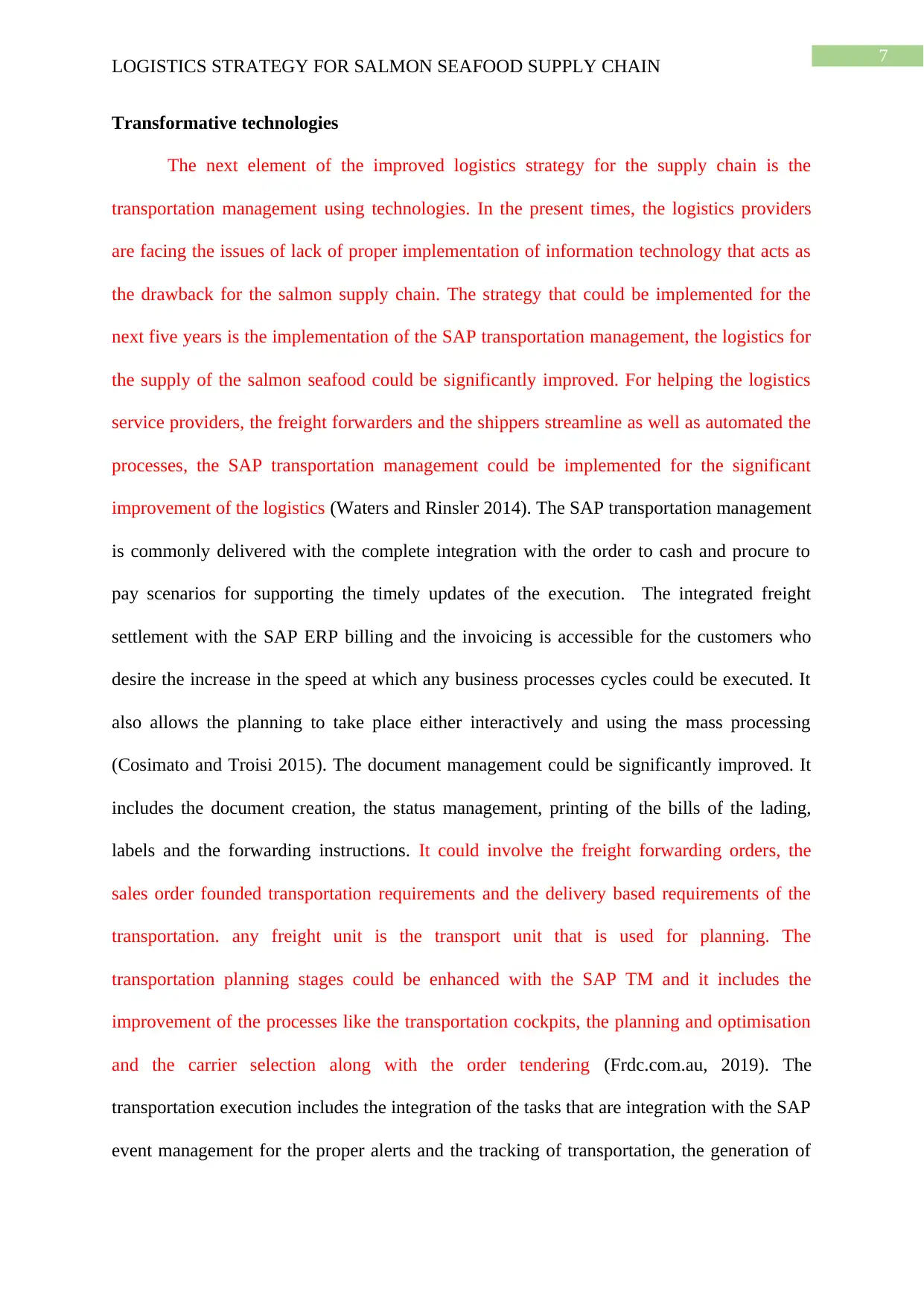
7
LOGISTICS STRATEGY FOR SALMON SEAFOOD SUPPLY CHAIN
Transformative technologies
The next element of the improved logistics strategy for the supply chain is the
transportation management using technologies. In the present times, the logistics providers
are facing the issues of lack of proper implementation of information technology that acts as
the drawback for the salmon supply chain. The strategy that could be implemented for the
next five years is the implementation of the SAP transportation management, the logistics for
the supply of the salmon seafood could be significantly improved. For helping the logistics
service providers, the freight forwarders and the shippers streamline as well as automated the
processes, the SAP transportation management could be implemented for the significant
improvement of the logistics (Waters and Rinsler 2014). The SAP transportation management
is commonly delivered with the complete integration with the order to cash and procure to
pay scenarios for supporting the timely updates of the execution. The integrated freight
settlement with the SAP ERP billing and the invoicing is accessible for the customers who
desire the increase in the speed at which any business processes cycles could be executed. It
also allows the planning to take place either interactively and using the mass processing
(Cosimato and Troisi 2015). The document management could be significantly improved. It
includes the document creation, the status management, printing of the bills of the lading,
labels and the forwarding instructions. It could involve the freight forwarding orders, the
sales order founded transportation requirements and the delivery based requirements of the
transportation. any freight unit is the transport unit that is used for planning. The
transportation planning stages could be enhanced with the SAP TM and it includes the
improvement of the processes like the transportation cockpits, the planning and optimisation
and the carrier selection along with the order tendering (Frdc.com.au, 2019). The
transportation execution includes the integration of the tasks that are integration with the SAP
event management for the proper alerts and the tracking of transportation, the generation of
LOGISTICS STRATEGY FOR SALMON SEAFOOD SUPPLY CHAIN
Transformative technologies
The next element of the improved logistics strategy for the supply chain is the
transportation management using technologies. In the present times, the logistics providers
are facing the issues of lack of proper implementation of information technology that acts as
the drawback for the salmon supply chain. The strategy that could be implemented for the
next five years is the implementation of the SAP transportation management, the logistics for
the supply of the salmon seafood could be significantly improved. For helping the logistics
service providers, the freight forwarders and the shippers streamline as well as automated the
processes, the SAP transportation management could be implemented for the significant
improvement of the logistics (Waters and Rinsler 2014). The SAP transportation management
is commonly delivered with the complete integration with the order to cash and procure to
pay scenarios for supporting the timely updates of the execution. The integrated freight
settlement with the SAP ERP billing and the invoicing is accessible for the customers who
desire the increase in the speed at which any business processes cycles could be executed. It
also allows the planning to take place either interactively and using the mass processing
(Cosimato and Troisi 2015). The document management could be significantly improved. It
includes the document creation, the status management, printing of the bills of the lading,
labels and the forwarding instructions. It could involve the freight forwarding orders, the
sales order founded transportation requirements and the delivery based requirements of the
transportation. any freight unit is the transport unit that is used for planning. The
transportation planning stages could be enhanced with the SAP TM and it includes the
improvement of the processes like the transportation cockpits, the planning and optimisation
and the carrier selection along with the order tendering (Frdc.com.au, 2019). The
transportation execution includes the integration of the tasks that are integration with the SAP
event management for the proper alerts and the tracking of transportation, the generation of
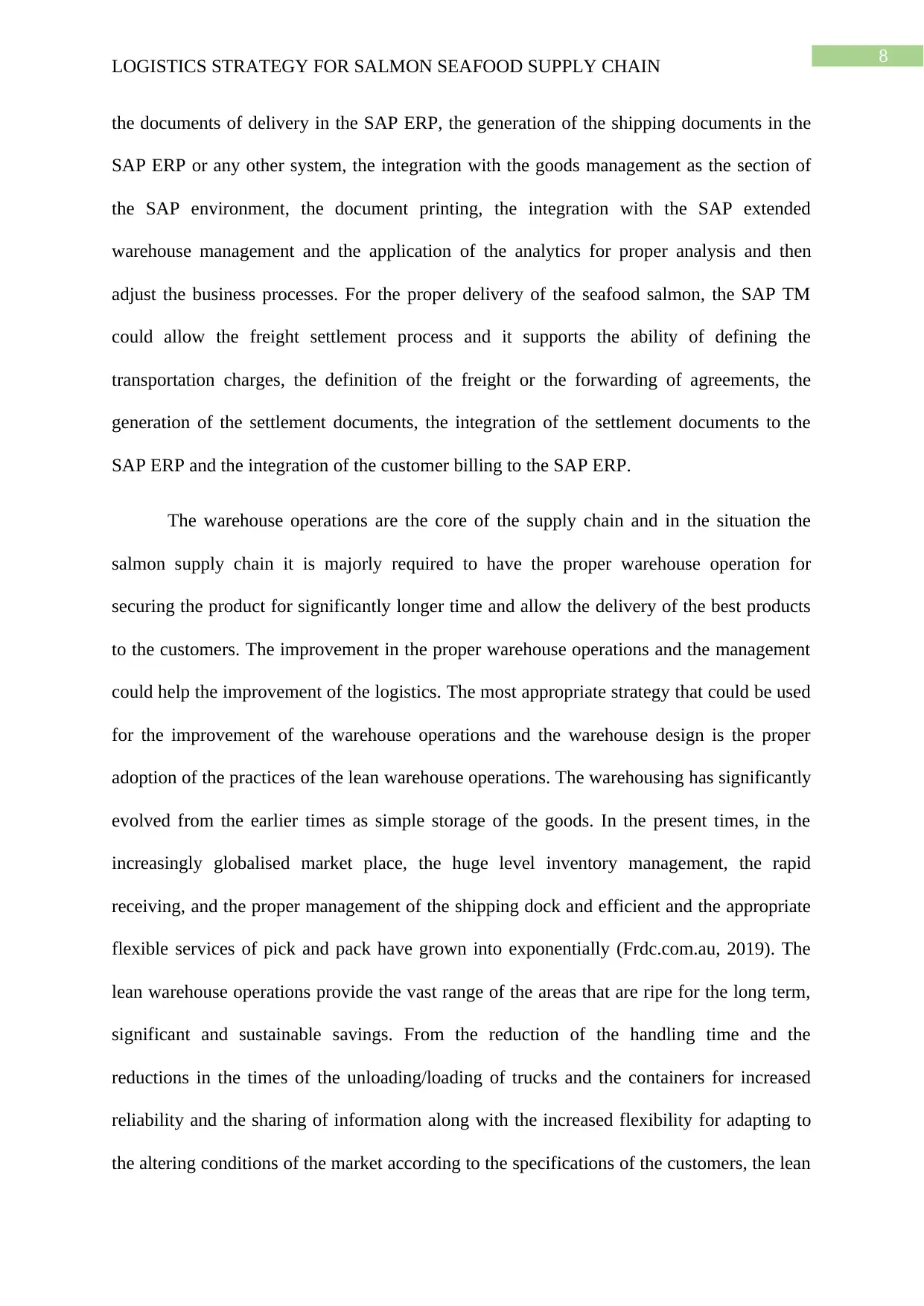
8
LOGISTICS STRATEGY FOR SALMON SEAFOOD SUPPLY CHAIN
the documents of delivery in the SAP ERP, the generation of the shipping documents in the
SAP ERP or any other system, the integration with the goods management as the section of
the SAP environment, the document printing, the integration with the SAP extended
warehouse management and the application of the analytics for proper analysis and then
adjust the business processes. For the proper delivery of the seafood salmon, the SAP TM
could allow the freight settlement process and it supports the ability of defining the
transportation charges, the definition of the freight or the forwarding of agreements, the
generation of the settlement documents, the integration of the settlement documents to the
SAP ERP and the integration of the customer billing to the SAP ERP.
The warehouse operations are the core of the supply chain and in the situation the
salmon supply chain it is majorly required to have the proper warehouse operation for
securing the product for significantly longer time and allow the delivery of the best products
to the customers. The improvement in the proper warehouse operations and the management
could help the improvement of the logistics. The most appropriate strategy that could be used
for the improvement of the warehouse operations and the warehouse design is the proper
adoption of the practices of the lean warehouse operations. The warehousing has significantly
evolved from the earlier times as simple storage of the goods. In the present times, in the
increasingly globalised market place, the huge level inventory management, the rapid
receiving, and the proper management of the shipping dock and efficient and the appropriate
flexible services of pick and pack have grown into exponentially (Frdc.com.au, 2019). The
lean warehouse operations provide the vast range of the areas that are ripe for the long term,
significant and sustainable savings. From the reduction of the handling time and the
reductions in the times of the unloading/loading of trucks and the containers for increased
reliability and the sharing of information along with the increased flexibility for adapting to
the altering conditions of the market according to the specifications of the customers, the lean
LOGISTICS STRATEGY FOR SALMON SEAFOOD SUPPLY CHAIN
the documents of delivery in the SAP ERP, the generation of the shipping documents in the
SAP ERP or any other system, the integration with the goods management as the section of
the SAP environment, the document printing, the integration with the SAP extended
warehouse management and the application of the analytics for proper analysis and then
adjust the business processes. For the proper delivery of the seafood salmon, the SAP TM
could allow the freight settlement process and it supports the ability of defining the
transportation charges, the definition of the freight or the forwarding of agreements, the
generation of the settlement documents, the integration of the settlement documents to the
SAP ERP and the integration of the customer billing to the SAP ERP.
The warehouse operations are the core of the supply chain and in the situation the
salmon supply chain it is majorly required to have the proper warehouse operation for
securing the product for significantly longer time and allow the delivery of the best products
to the customers. The improvement in the proper warehouse operations and the management
could help the improvement of the logistics. The most appropriate strategy that could be used
for the improvement of the warehouse operations and the warehouse design is the proper
adoption of the practices of the lean warehouse operations. The warehousing has significantly
evolved from the earlier times as simple storage of the goods. In the present times, in the
increasingly globalised market place, the huge level inventory management, the rapid
receiving, and the proper management of the shipping dock and efficient and the appropriate
flexible services of pick and pack have grown into exponentially (Frdc.com.au, 2019). The
lean warehouse operations provide the vast range of the areas that are ripe for the long term,
significant and sustainable savings. From the reduction of the handling time and the
reductions in the times of the unloading/loading of trucks and the containers for increased
reliability and the sharing of information along with the increased flexibility for adapting to
the altering conditions of the market according to the specifications of the customers, the lean
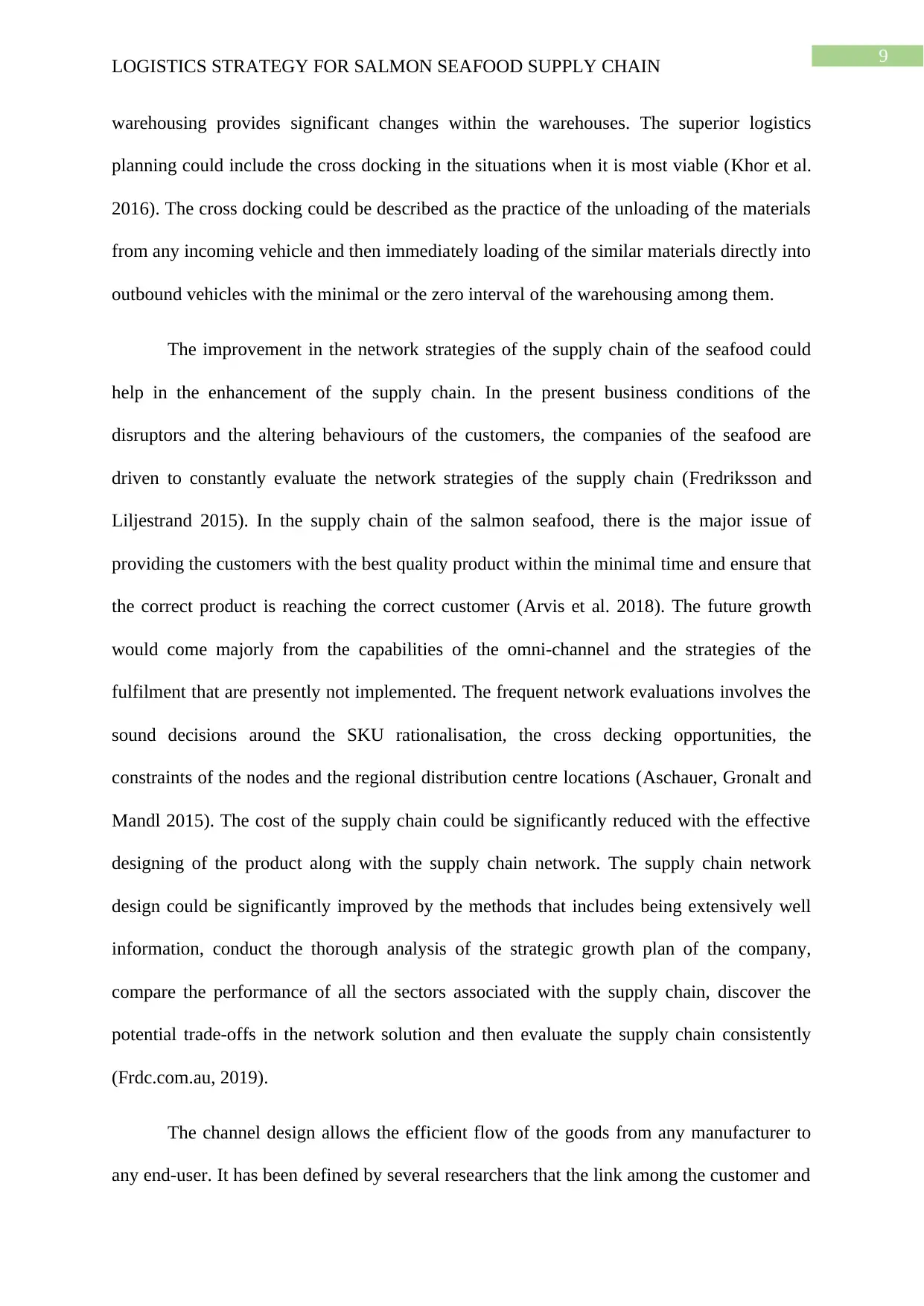
9
LOGISTICS STRATEGY FOR SALMON SEAFOOD SUPPLY CHAIN
warehousing provides significant changes within the warehouses. The superior logistics
planning could include the cross docking in the situations when it is most viable (Khor et al.
2016). The cross docking could be described as the practice of the unloading of the materials
from any incoming vehicle and then immediately loading of the similar materials directly into
outbound vehicles with the minimal or the zero interval of the warehousing among them.
The improvement in the network strategies of the supply chain of the seafood could
help in the enhancement of the supply chain. In the present business conditions of the
disruptors and the altering behaviours of the customers, the companies of the seafood are
driven to constantly evaluate the network strategies of the supply chain (Fredriksson and
Liljestrand 2015). In the supply chain of the salmon seafood, there is the major issue of
providing the customers with the best quality product within the minimal time and ensure that
the correct product is reaching the correct customer (Arvis et al. 2018). The future growth
would come majorly from the capabilities of the omni-channel and the strategies of the
fulfilment that are presently not implemented. The frequent network evaluations involves the
sound decisions around the SKU rationalisation, the cross decking opportunities, the
constraints of the nodes and the regional distribution centre locations (Aschauer, Gronalt and
Mandl 2015). The cost of the supply chain could be significantly reduced with the effective
designing of the product along with the supply chain network. The supply chain network
design could be significantly improved by the methods that includes being extensively well
information, conduct the thorough analysis of the strategic growth plan of the company,
compare the performance of all the sectors associated with the supply chain, discover the
potential trade-offs in the network solution and then evaluate the supply chain consistently
(Frdc.com.au, 2019).
The channel design allows the efficient flow of the goods from any manufacturer to
any end-user. It has been defined by several researchers that the link among the customer and
LOGISTICS STRATEGY FOR SALMON SEAFOOD SUPPLY CHAIN
warehousing provides significant changes within the warehouses. The superior logistics
planning could include the cross docking in the situations when it is most viable (Khor et al.
2016). The cross docking could be described as the practice of the unloading of the materials
from any incoming vehicle and then immediately loading of the similar materials directly into
outbound vehicles with the minimal or the zero interval of the warehousing among them.
The improvement in the network strategies of the supply chain of the seafood could
help in the enhancement of the supply chain. In the present business conditions of the
disruptors and the altering behaviours of the customers, the companies of the seafood are
driven to constantly evaluate the network strategies of the supply chain (Fredriksson and
Liljestrand 2015). In the supply chain of the salmon seafood, there is the major issue of
providing the customers with the best quality product within the minimal time and ensure that
the correct product is reaching the correct customer (Arvis et al. 2018). The future growth
would come majorly from the capabilities of the omni-channel and the strategies of the
fulfilment that are presently not implemented. The frequent network evaluations involves the
sound decisions around the SKU rationalisation, the cross decking opportunities, the
constraints of the nodes and the regional distribution centre locations (Aschauer, Gronalt and
Mandl 2015). The cost of the supply chain could be significantly reduced with the effective
designing of the product along with the supply chain network. The supply chain network
design could be significantly improved by the methods that includes being extensively well
information, conduct the thorough analysis of the strategic growth plan of the company,
compare the performance of all the sectors associated with the supply chain, discover the
potential trade-offs in the network solution and then evaluate the supply chain consistently
(Frdc.com.au, 2019).
The channel design allows the efficient flow of the goods from any manufacturer to
any end-user. It has been defined by several researchers that the link among the customer and
Secure Best Marks with AI Grader
Need help grading? Try our AI Grader for instant feedback on your assignments.
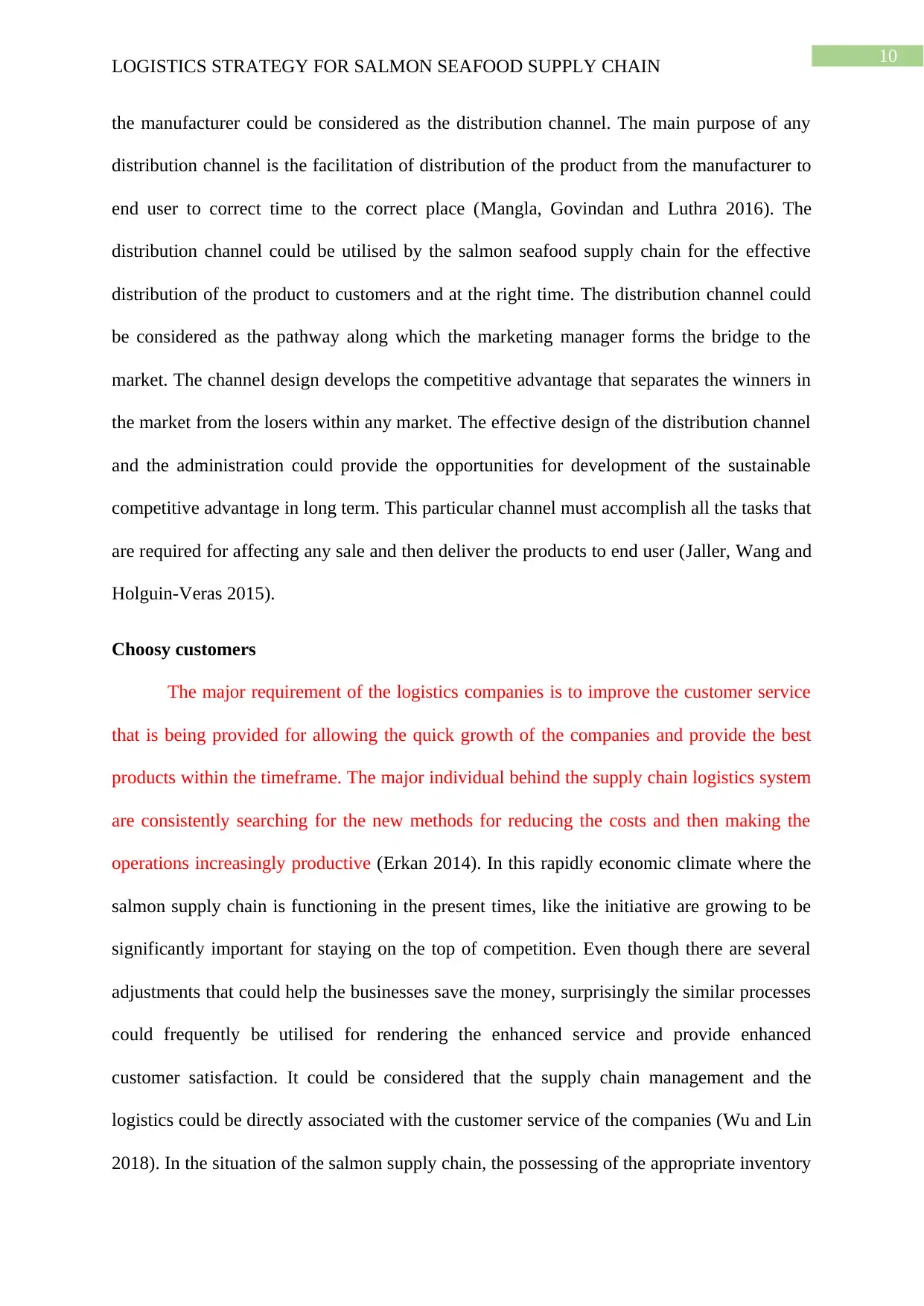
10
LOGISTICS STRATEGY FOR SALMON SEAFOOD SUPPLY CHAIN
the manufacturer could be considered as the distribution channel. The main purpose of any
distribution channel is the facilitation of distribution of the product from the manufacturer to
end user to correct time to the correct place (Mangla, Govindan and Luthra 2016). The
distribution channel could be utilised by the salmon seafood supply chain for the effective
distribution of the product to customers and at the right time. The distribution channel could
be considered as the pathway along which the marketing manager forms the bridge to the
market. The channel design develops the competitive advantage that separates the winners in
the market from the losers within any market. The effective design of the distribution channel
and the administration could provide the opportunities for development of the sustainable
competitive advantage in long term. This particular channel must accomplish all the tasks that
are required for affecting any sale and then deliver the products to end user (Jaller, Wang and
Holguin-Veras 2015).
Choosy customers
The major requirement of the logistics companies is to improve the customer service
that is being provided for allowing the quick growth of the companies and provide the best
products within the timeframe. The major individual behind the supply chain logistics system
are consistently searching for the new methods for reducing the costs and then making the
operations increasingly productive (Erkan 2014). In this rapidly economic climate where the
salmon supply chain is functioning in the present times, like the initiative are growing to be
significantly important for staying on the top of competition. Even though there are several
adjustments that could help the businesses save the money, surprisingly the similar processes
could frequently be utilised for rendering the enhanced service and provide enhanced
customer satisfaction. It could be considered that the supply chain management and the
logistics could be directly associated with the customer service of the companies (Wu and Lin
2018). In the situation of the salmon supply chain, the possessing of the appropriate inventory
LOGISTICS STRATEGY FOR SALMON SEAFOOD SUPPLY CHAIN
the manufacturer could be considered as the distribution channel. The main purpose of any
distribution channel is the facilitation of distribution of the product from the manufacturer to
end user to correct time to the correct place (Mangla, Govindan and Luthra 2016). The
distribution channel could be utilised by the salmon seafood supply chain for the effective
distribution of the product to customers and at the right time. The distribution channel could
be considered as the pathway along which the marketing manager forms the bridge to the
market. The channel design develops the competitive advantage that separates the winners in
the market from the losers within any market. The effective design of the distribution channel
and the administration could provide the opportunities for development of the sustainable
competitive advantage in long term. This particular channel must accomplish all the tasks that
are required for affecting any sale and then deliver the products to end user (Jaller, Wang and
Holguin-Veras 2015).
Choosy customers
The major requirement of the logistics companies is to improve the customer service
that is being provided for allowing the quick growth of the companies and provide the best
products within the timeframe. The major individual behind the supply chain logistics system
are consistently searching for the new methods for reducing the costs and then making the
operations increasingly productive (Erkan 2014). In this rapidly economic climate where the
salmon supply chain is functioning in the present times, like the initiative are growing to be
significantly important for staying on the top of competition. Even though there are several
adjustments that could help the businesses save the money, surprisingly the similar processes
could frequently be utilised for rendering the enhanced service and provide enhanced
customer satisfaction. It could be considered that the supply chain management and the
logistics could be directly associated with the customer service of the companies (Wu and Lin
2018). In the situation of the salmon supply chain, the possessing of the appropriate inventory
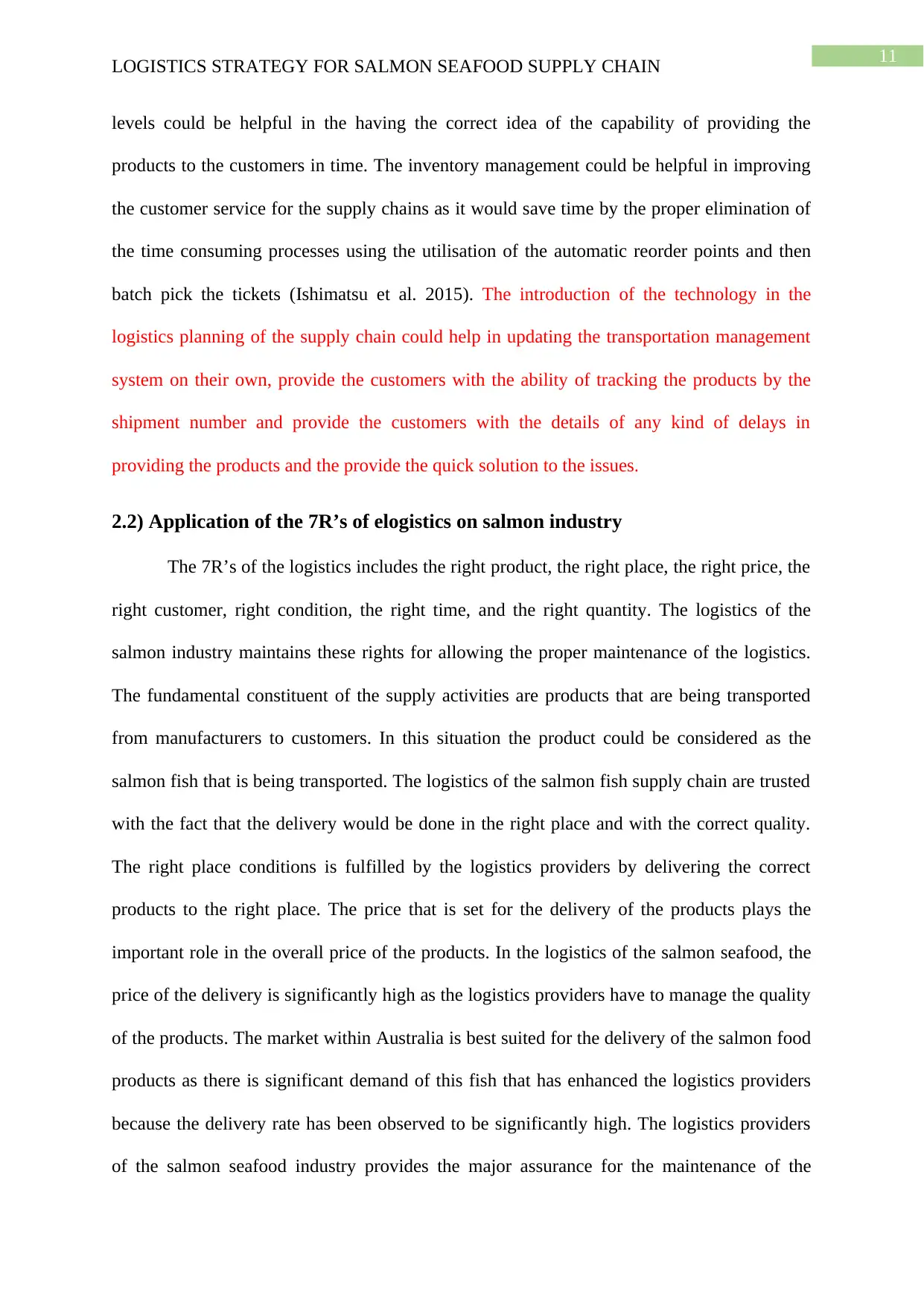
11
LOGISTICS STRATEGY FOR SALMON SEAFOOD SUPPLY CHAIN
levels could be helpful in the having the correct idea of the capability of providing the
products to the customers in time. The inventory management could be helpful in improving
the customer service for the supply chains as it would save time by the proper elimination of
the time consuming processes using the utilisation of the automatic reorder points and then
batch pick the tickets (Ishimatsu et al. 2015). The introduction of the technology in the
logistics planning of the supply chain could help in updating the transportation management
system on their own, provide the customers with the ability of tracking the products by the
shipment number and provide the customers with the details of any kind of delays in
providing the products and the provide the quick solution to the issues.
2.2) Application of the 7R’s of elogistics on salmon industry
The 7R’s of the logistics includes the right product, the right place, the right price, the
right customer, right condition, the right time, and the right quantity. The logistics of the
salmon industry maintains these rights for allowing the proper maintenance of the logistics.
The fundamental constituent of the supply activities are products that are being transported
from manufacturers to customers. In this situation the product could be considered as the
salmon fish that is being transported. The logistics of the salmon fish supply chain are trusted
with the fact that the delivery would be done in the right place and with the correct quality.
The right place conditions is fulfilled by the logistics providers by delivering the correct
products to the right place. The price that is set for the delivery of the products plays the
important role in the overall price of the products. In the logistics of the salmon seafood, the
price of the delivery is significantly high as the logistics providers have to manage the quality
of the products. The market within Australia is best suited for the delivery of the salmon food
products as there is significant demand of this fish that has enhanced the logistics providers
because the delivery rate has been observed to be significantly high. The logistics providers
of the salmon seafood industry provides the major assurance for the maintenance of the
LOGISTICS STRATEGY FOR SALMON SEAFOOD SUPPLY CHAIN
levels could be helpful in the having the correct idea of the capability of providing the
products to the customers in time. The inventory management could be helpful in improving
the customer service for the supply chains as it would save time by the proper elimination of
the time consuming processes using the utilisation of the automatic reorder points and then
batch pick the tickets (Ishimatsu et al. 2015). The introduction of the technology in the
logistics planning of the supply chain could help in updating the transportation management
system on their own, provide the customers with the ability of tracking the products by the
shipment number and provide the customers with the details of any kind of delays in
providing the products and the provide the quick solution to the issues.
2.2) Application of the 7R’s of elogistics on salmon industry
The 7R’s of the logistics includes the right product, the right place, the right price, the
right customer, right condition, the right time, and the right quantity. The logistics of the
salmon industry maintains these rights for allowing the proper maintenance of the logistics.
The fundamental constituent of the supply activities are products that are being transported
from manufacturers to customers. In this situation the product could be considered as the
salmon fish that is being transported. The logistics of the salmon fish supply chain are trusted
with the fact that the delivery would be done in the right place and with the correct quality.
The right place conditions is fulfilled by the logistics providers by delivering the correct
products to the right place. The price that is set for the delivery of the products plays the
important role in the overall price of the products. In the logistics of the salmon seafood, the
price of the delivery is significantly high as the logistics providers have to manage the quality
of the products. The market within Australia is best suited for the delivery of the salmon food
products as there is significant demand of this fish that has enhanced the logistics providers
because the delivery rate has been observed to be significantly high. The logistics providers
of the salmon seafood industry provides the major assurance for the maintenance of the
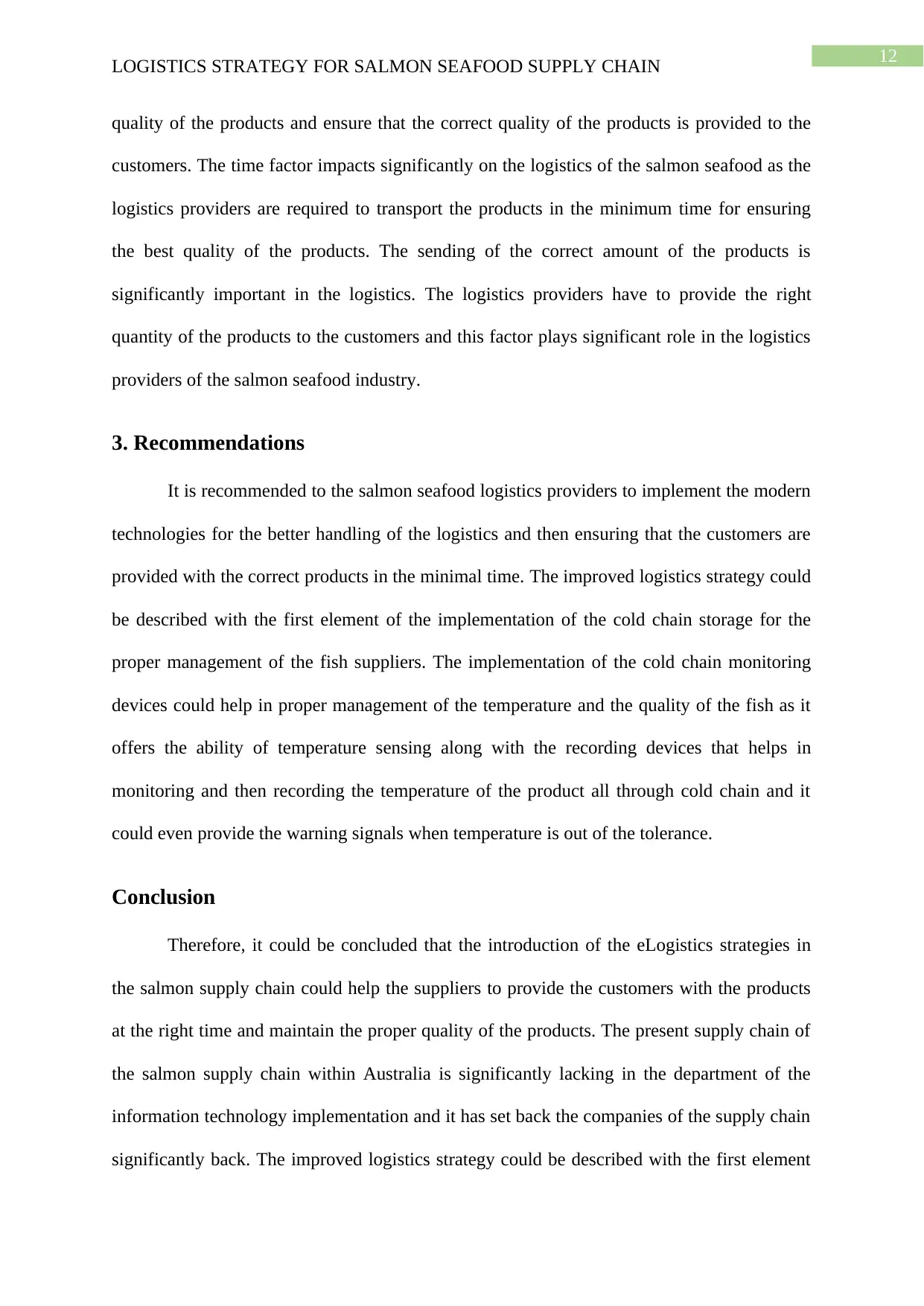
12
LOGISTICS STRATEGY FOR SALMON SEAFOOD SUPPLY CHAIN
quality of the products and ensure that the correct quality of the products is provided to the
customers. The time factor impacts significantly on the logistics of the salmon seafood as the
logistics providers are required to transport the products in the minimum time for ensuring
the best quality of the products. The sending of the correct amount of the products is
significantly important in the logistics. The logistics providers have to provide the right
quantity of the products to the customers and this factor plays significant role in the logistics
providers of the salmon seafood industry.
3. Recommendations
It is recommended to the salmon seafood logistics providers to implement the modern
technologies for the better handling of the logistics and then ensuring that the customers are
provided with the correct products in the minimal time. The improved logistics strategy could
be described with the first element of the implementation of the cold chain storage for the
proper management of the fish suppliers. The implementation of the cold chain monitoring
devices could help in proper management of the temperature and the quality of the fish as it
offers the ability of temperature sensing along with the recording devices that helps in
monitoring and then recording the temperature of the product all through cold chain and it
could even provide the warning signals when temperature is out of the tolerance.
Conclusion
Therefore, it could be concluded that the introduction of the eLogistics strategies in
the salmon supply chain could help the suppliers to provide the customers with the products
at the right time and maintain the proper quality of the products. The present supply chain of
the salmon supply chain within Australia is significantly lacking in the department of the
information technology implementation and it has set back the companies of the supply chain
significantly back. The improved logistics strategy could be described with the first element
LOGISTICS STRATEGY FOR SALMON SEAFOOD SUPPLY CHAIN
quality of the products and ensure that the correct quality of the products is provided to the
customers. The time factor impacts significantly on the logistics of the salmon seafood as the
logistics providers are required to transport the products in the minimum time for ensuring
the best quality of the products. The sending of the correct amount of the products is
significantly important in the logistics. The logistics providers have to provide the right
quantity of the products to the customers and this factor plays significant role in the logistics
providers of the salmon seafood industry.
3. Recommendations
It is recommended to the salmon seafood logistics providers to implement the modern
technologies for the better handling of the logistics and then ensuring that the customers are
provided with the correct products in the minimal time. The improved logistics strategy could
be described with the first element of the implementation of the cold chain storage for the
proper management of the fish suppliers. The implementation of the cold chain monitoring
devices could help in proper management of the temperature and the quality of the fish as it
offers the ability of temperature sensing along with the recording devices that helps in
monitoring and then recording the temperature of the product all through cold chain and it
could even provide the warning signals when temperature is out of the tolerance.
Conclusion
Therefore, it could be concluded that the introduction of the eLogistics strategies in
the salmon supply chain could help the suppliers to provide the customers with the products
at the right time and maintain the proper quality of the products. The present supply chain of
the salmon supply chain within Australia is significantly lacking in the department of the
information technology implementation and it has set back the companies of the supply chain
significantly back. The improved logistics strategy could be described with the first element
Paraphrase This Document
Need a fresh take? Get an instant paraphrase of this document with our AI Paraphraser
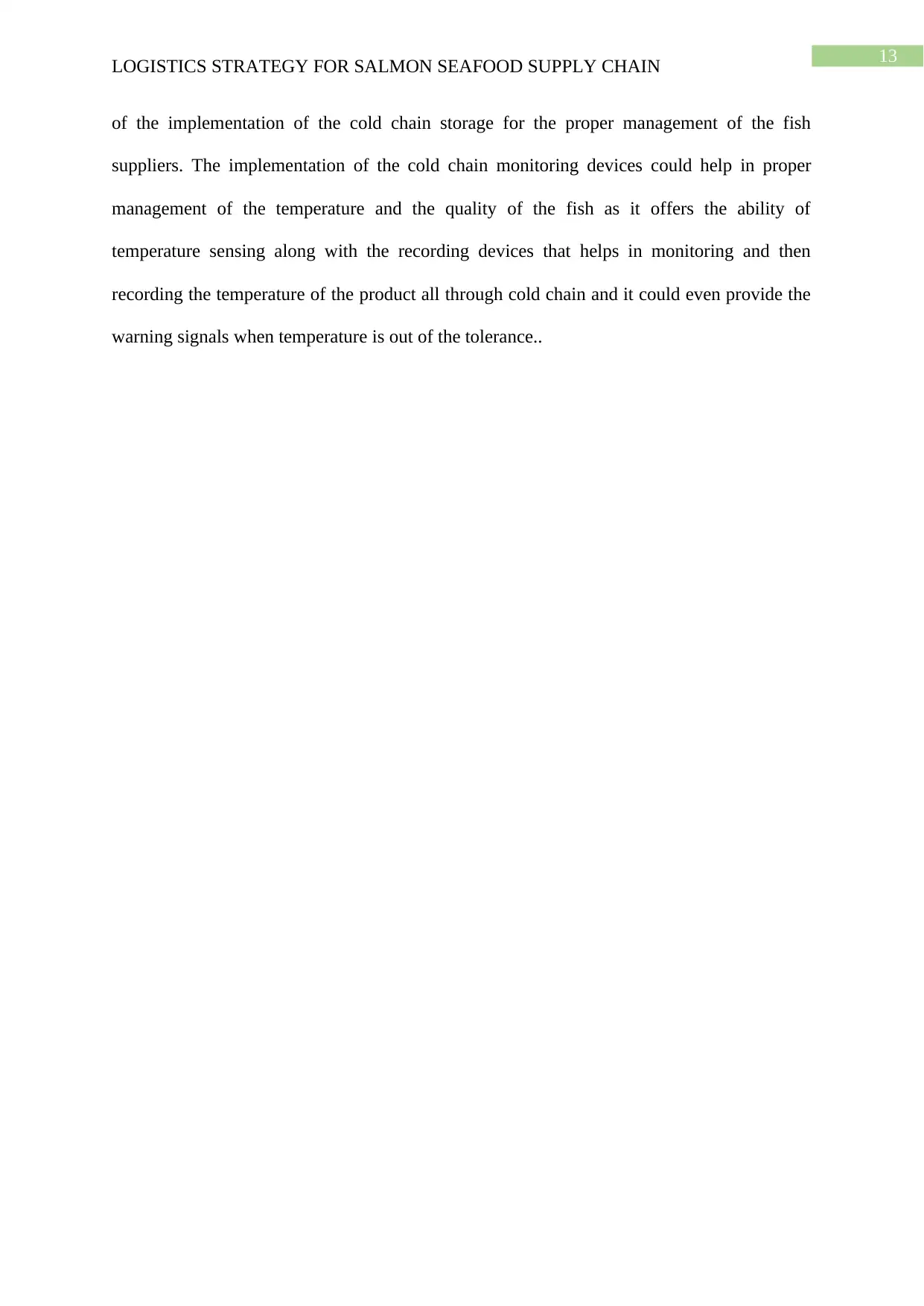
13
LOGISTICS STRATEGY FOR SALMON SEAFOOD SUPPLY CHAIN
of the implementation of the cold chain storage for the proper management of the fish
suppliers. The implementation of the cold chain monitoring devices could help in proper
management of the temperature and the quality of the fish as it offers the ability of
temperature sensing along with the recording devices that helps in monitoring and then
recording the temperature of the product all through cold chain and it could even provide the
warning signals when temperature is out of the tolerance..
LOGISTICS STRATEGY FOR SALMON SEAFOOD SUPPLY CHAIN
of the implementation of the cold chain storage for the proper management of the fish
suppliers. The implementation of the cold chain monitoring devices could help in proper
management of the temperature and the quality of the fish as it offers the ability of
temperature sensing along with the recording devices that helps in monitoring and then
recording the temperature of the product all through cold chain and it could even provide the
warning signals when temperature is out of the tolerance..
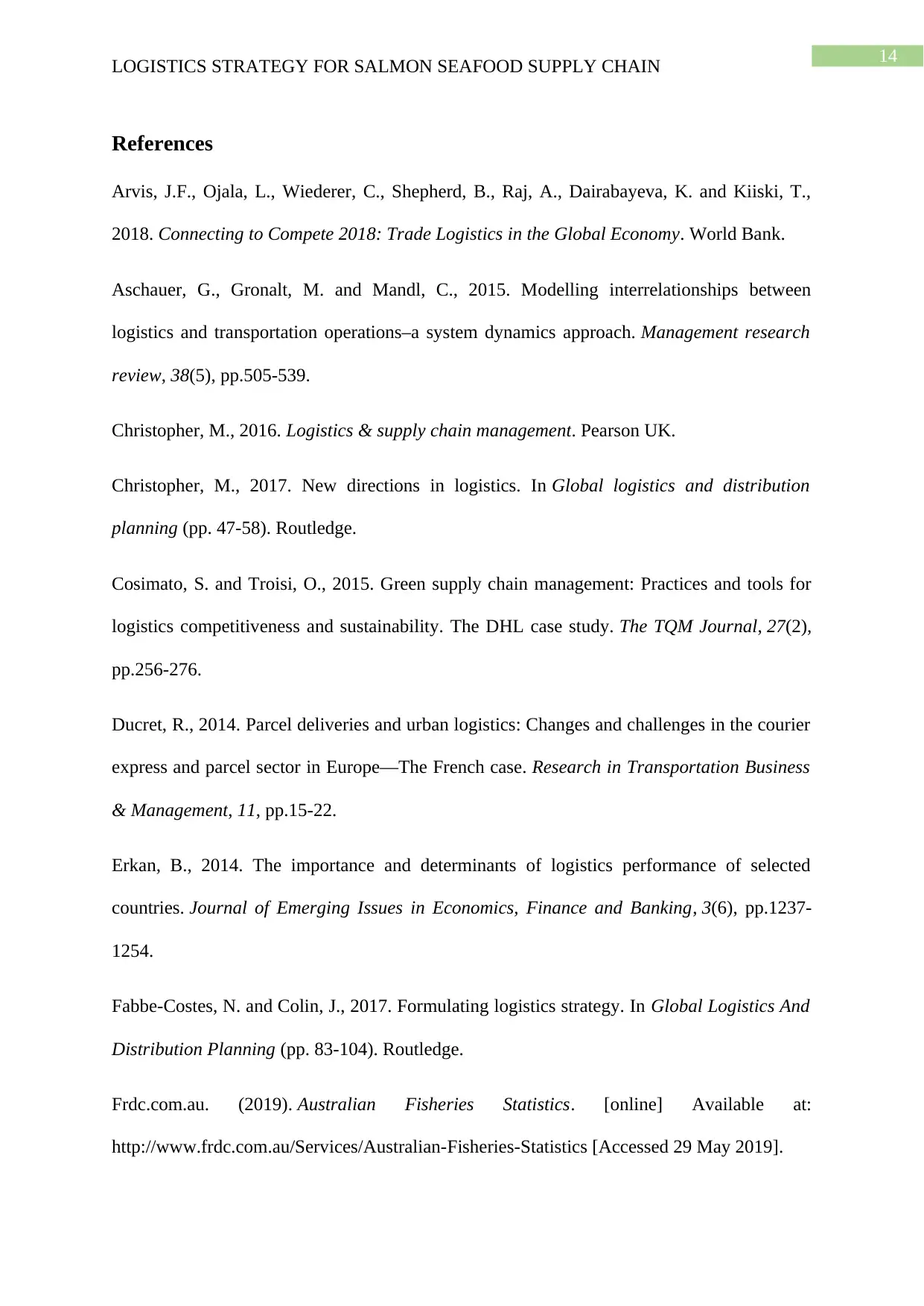
14
LOGISTICS STRATEGY FOR SALMON SEAFOOD SUPPLY CHAIN
References
Arvis, J.F., Ojala, L., Wiederer, C., Shepherd, B., Raj, A., Dairabayeva, K. and Kiiski, T.,
2018. Connecting to Compete 2018: Trade Logistics in the Global Economy. World Bank.
Aschauer, G., Gronalt, M. and Mandl, C., 2015. Modelling interrelationships between
logistics and transportation operations–a system dynamics approach. Management research
review, 38(5), pp.505-539.
Christopher, M., 2016. Logistics & supply chain management. Pearson UK.
Christopher, M., 2017. New directions in logistics. In Global logistics and distribution
planning (pp. 47-58). Routledge.
Cosimato, S. and Troisi, O., 2015. Green supply chain management: Practices and tools for
logistics competitiveness and sustainability. The DHL case study. The TQM Journal, 27(2),
pp.256-276.
Ducret, R., 2014. Parcel deliveries and urban logistics: Changes and challenges in the courier
express and parcel sector in Europe—The French case. Research in Transportation Business
& Management, 11, pp.15-22.
Erkan, B., 2014. The importance and determinants of logistics performance of selected
countries. Journal of Emerging Issues in Economics, Finance and Banking, 3(6), pp.1237-
1254.
Fabbe-Costes, N. and Colin, J., 2017. Formulating logistics strategy. In Global Logistics And
Distribution Planning (pp. 83-104). Routledge.
Frdc.com.au. (2019). Australian Fisheries Statistics. [online] Available at:
http://www.frdc.com.au/Services/Australian-Fisheries-Statistics [Accessed 29 May 2019].
LOGISTICS STRATEGY FOR SALMON SEAFOOD SUPPLY CHAIN
References
Arvis, J.F., Ojala, L., Wiederer, C., Shepherd, B., Raj, A., Dairabayeva, K. and Kiiski, T.,
2018. Connecting to Compete 2018: Trade Logistics in the Global Economy. World Bank.
Aschauer, G., Gronalt, M. and Mandl, C., 2015. Modelling interrelationships between
logistics and transportation operations–a system dynamics approach. Management research
review, 38(5), pp.505-539.
Christopher, M., 2016. Logistics & supply chain management. Pearson UK.
Christopher, M., 2017. New directions in logistics. In Global logistics and distribution
planning (pp. 47-58). Routledge.
Cosimato, S. and Troisi, O., 2015. Green supply chain management: Practices and tools for
logistics competitiveness and sustainability. The DHL case study. The TQM Journal, 27(2),
pp.256-276.
Ducret, R., 2014. Parcel deliveries and urban logistics: Changes and challenges in the courier
express and parcel sector in Europe—The French case. Research in Transportation Business
& Management, 11, pp.15-22.
Erkan, B., 2014. The importance and determinants of logistics performance of selected
countries. Journal of Emerging Issues in Economics, Finance and Banking, 3(6), pp.1237-
1254.
Fabbe-Costes, N. and Colin, J., 2017. Formulating logistics strategy. In Global Logistics And
Distribution Planning (pp. 83-104). Routledge.
Frdc.com.au. (2019). Australian Fisheries Statistics. [online] Available at:
http://www.frdc.com.au/Services/Australian-Fisheries-Statistics [Accessed 29 May 2019].
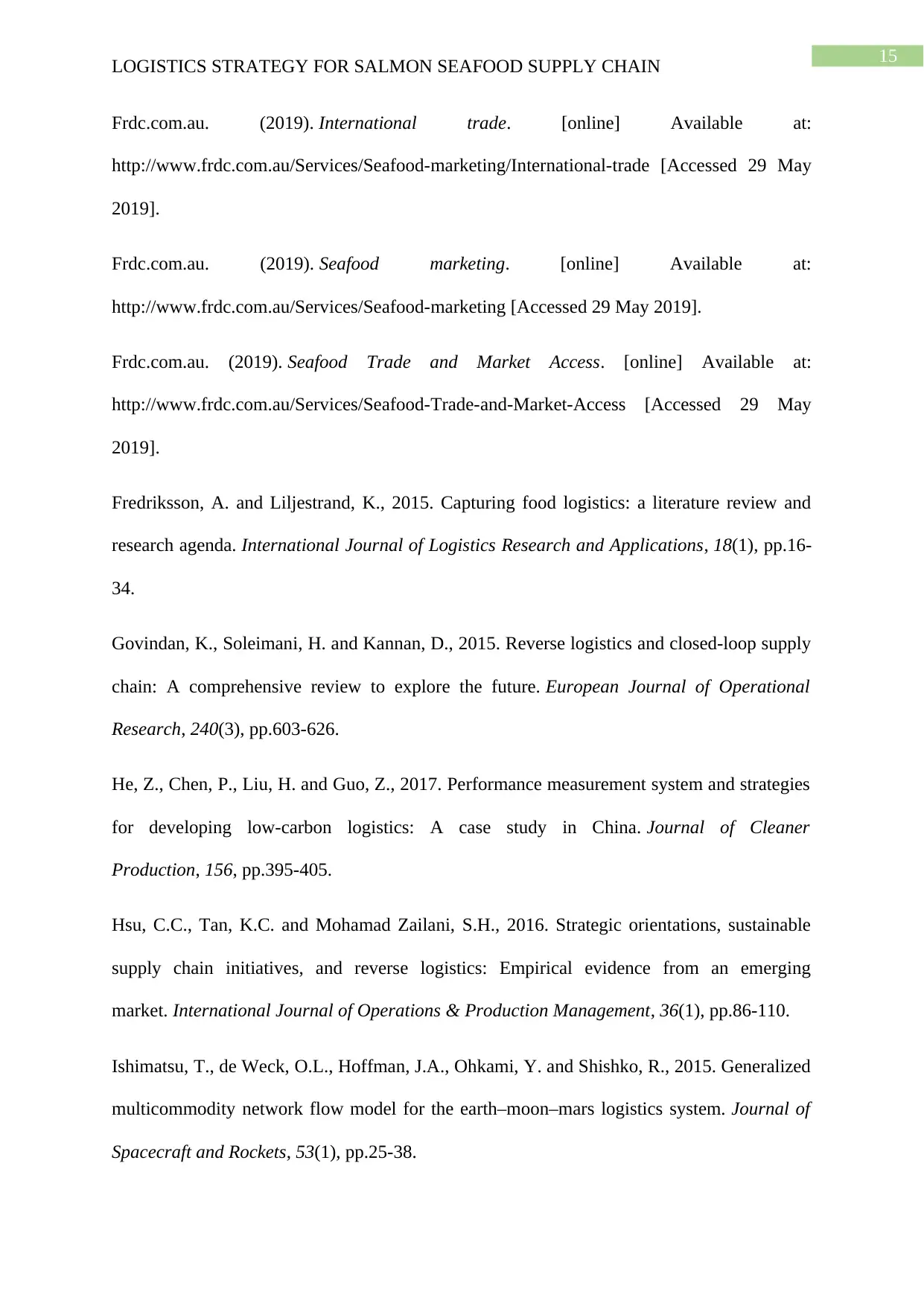
15
LOGISTICS STRATEGY FOR SALMON SEAFOOD SUPPLY CHAIN
Frdc.com.au. (2019). International trade. [online] Available at:
http://www.frdc.com.au/Services/Seafood-marketing/International-trade [Accessed 29 May
2019].
Frdc.com.au. (2019). Seafood marketing. [online] Available at:
http://www.frdc.com.au/Services/Seafood-marketing [Accessed 29 May 2019].
Frdc.com.au. (2019). Seafood Trade and Market Access. [online] Available at:
http://www.frdc.com.au/Services/Seafood-Trade-and-Market-Access [Accessed 29 May
2019].
Fredriksson, A. and Liljestrand, K., 2015. Capturing food logistics: a literature review and
research agenda. International Journal of Logistics Research and Applications, 18(1), pp.16-
34.
Govindan, K., Soleimani, H. and Kannan, D., 2015. Reverse logistics and closed-loop supply
chain: A comprehensive review to explore the future. European Journal of Operational
Research, 240(3), pp.603-626.
He, Z., Chen, P., Liu, H. and Guo, Z., 2017. Performance measurement system and strategies
for developing low-carbon logistics: A case study in China. Journal of Cleaner
Production, 156, pp.395-405.
Hsu, C.C., Tan, K.C. and Mohamad Zailani, S.H., 2016. Strategic orientations, sustainable
supply chain initiatives, and reverse logistics: Empirical evidence from an emerging
market. International Journal of Operations & Production Management, 36(1), pp.86-110.
Ishimatsu, T., de Weck, O.L., Hoffman, J.A., Ohkami, Y. and Shishko, R., 2015. Generalized
multicommodity network flow model for the earth–moon–mars logistics system. Journal of
Spacecraft and Rockets, 53(1), pp.25-38.
LOGISTICS STRATEGY FOR SALMON SEAFOOD SUPPLY CHAIN
Frdc.com.au. (2019). International trade. [online] Available at:
http://www.frdc.com.au/Services/Seafood-marketing/International-trade [Accessed 29 May
2019].
Frdc.com.au. (2019). Seafood marketing. [online] Available at:
http://www.frdc.com.au/Services/Seafood-marketing [Accessed 29 May 2019].
Frdc.com.au. (2019). Seafood Trade and Market Access. [online] Available at:
http://www.frdc.com.au/Services/Seafood-Trade-and-Market-Access [Accessed 29 May
2019].
Fredriksson, A. and Liljestrand, K., 2015. Capturing food logistics: a literature review and
research agenda. International Journal of Logistics Research and Applications, 18(1), pp.16-
34.
Govindan, K., Soleimani, H. and Kannan, D., 2015. Reverse logistics and closed-loop supply
chain: A comprehensive review to explore the future. European Journal of Operational
Research, 240(3), pp.603-626.
He, Z., Chen, P., Liu, H. and Guo, Z., 2017. Performance measurement system and strategies
for developing low-carbon logistics: A case study in China. Journal of Cleaner
Production, 156, pp.395-405.
Hsu, C.C., Tan, K.C. and Mohamad Zailani, S.H., 2016. Strategic orientations, sustainable
supply chain initiatives, and reverse logistics: Empirical evidence from an emerging
market. International Journal of Operations & Production Management, 36(1), pp.86-110.
Ishimatsu, T., de Weck, O.L., Hoffman, J.A., Ohkami, Y. and Shishko, R., 2015. Generalized
multicommodity network flow model for the earth–moon–mars logistics system. Journal of
Spacecraft and Rockets, 53(1), pp.25-38.
Secure Best Marks with AI Grader
Need help grading? Try our AI Grader for instant feedback on your assignments.
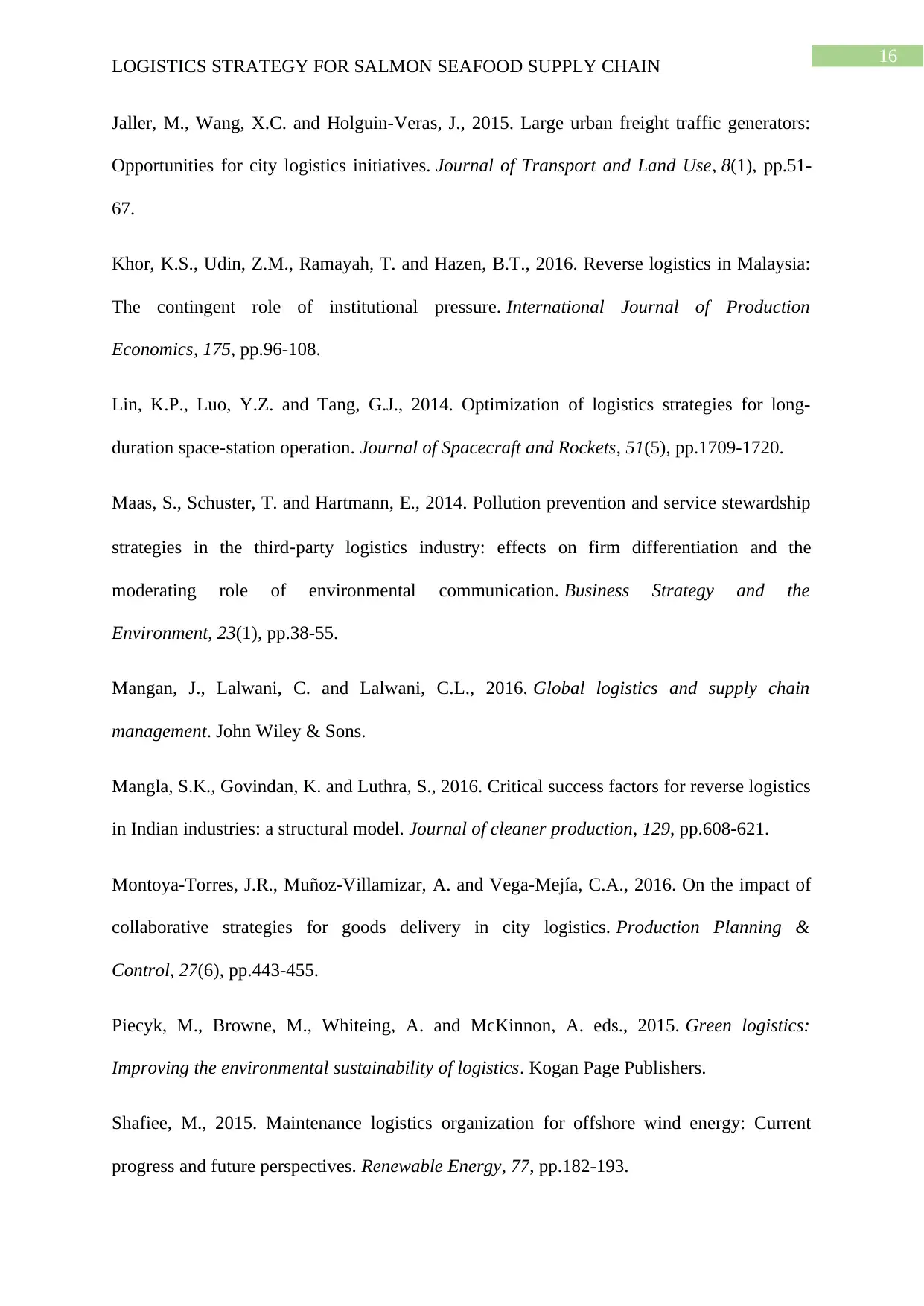
16
LOGISTICS STRATEGY FOR SALMON SEAFOOD SUPPLY CHAIN
Jaller, M., Wang, X.C. and Holguin-Veras, J., 2015. Large urban freight traffic generators:
Opportunities for city logistics initiatives. Journal of Transport and Land Use, 8(1), pp.51-
67.
Khor, K.S., Udin, Z.M., Ramayah, T. and Hazen, B.T., 2016. Reverse logistics in Malaysia:
The contingent role of institutional pressure. International Journal of Production
Economics, 175, pp.96-108.
Lin, K.P., Luo, Y.Z. and Tang, G.J., 2014. Optimization of logistics strategies for long-
duration space-station operation. Journal of Spacecraft and Rockets, 51(5), pp.1709-1720.
Maas, S., Schuster, T. and Hartmann, E., 2014. Pollution prevention and service stewardship
strategies in the third‐party logistics industry: effects on firm differentiation and the
moderating role of environmental communication. Business Strategy and the
Environment, 23(1), pp.38-55.
Mangan, J., Lalwani, C. and Lalwani, C.L., 2016. Global logistics and supply chain
management. John Wiley & Sons.
Mangla, S.K., Govindan, K. and Luthra, S., 2016. Critical success factors for reverse logistics
in Indian industries: a structural model. Journal of cleaner production, 129, pp.608-621.
Montoya-Torres, J.R., Muñoz-Villamizar, A. and Vega-Mejía, C.A., 2016. On the impact of
collaborative strategies for goods delivery in city logistics. Production Planning &
Control, 27(6), pp.443-455.
Piecyk, M., Browne, M., Whiteing, A. and McKinnon, A. eds., 2015. Green logistics:
Improving the environmental sustainability of logistics. Kogan Page Publishers.
Shafiee, M., 2015. Maintenance logistics organization for offshore wind energy: Current
progress and future perspectives. Renewable Energy, 77, pp.182-193.
LOGISTICS STRATEGY FOR SALMON SEAFOOD SUPPLY CHAIN
Jaller, M., Wang, X.C. and Holguin-Veras, J., 2015. Large urban freight traffic generators:
Opportunities for city logistics initiatives. Journal of Transport and Land Use, 8(1), pp.51-
67.
Khor, K.S., Udin, Z.M., Ramayah, T. and Hazen, B.T., 2016. Reverse logistics in Malaysia:
The contingent role of institutional pressure. International Journal of Production
Economics, 175, pp.96-108.
Lin, K.P., Luo, Y.Z. and Tang, G.J., 2014. Optimization of logistics strategies for long-
duration space-station operation. Journal of Spacecraft and Rockets, 51(5), pp.1709-1720.
Maas, S., Schuster, T. and Hartmann, E., 2014. Pollution prevention and service stewardship
strategies in the third‐party logistics industry: effects on firm differentiation and the
moderating role of environmental communication. Business Strategy and the
Environment, 23(1), pp.38-55.
Mangan, J., Lalwani, C. and Lalwani, C.L., 2016. Global logistics and supply chain
management. John Wiley & Sons.
Mangla, S.K., Govindan, K. and Luthra, S., 2016. Critical success factors for reverse logistics
in Indian industries: a structural model. Journal of cleaner production, 129, pp.608-621.
Montoya-Torres, J.R., Muñoz-Villamizar, A. and Vega-Mejía, C.A., 2016. On the impact of
collaborative strategies for goods delivery in city logistics. Production Planning &
Control, 27(6), pp.443-455.
Piecyk, M., Browne, M., Whiteing, A. and McKinnon, A. eds., 2015. Green logistics:
Improving the environmental sustainability of logistics. Kogan Page Publishers.
Shafiee, M., 2015. Maintenance logistics organization for offshore wind energy: Current
progress and future perspectives. Renewable Energy, 77, pp.182-193.
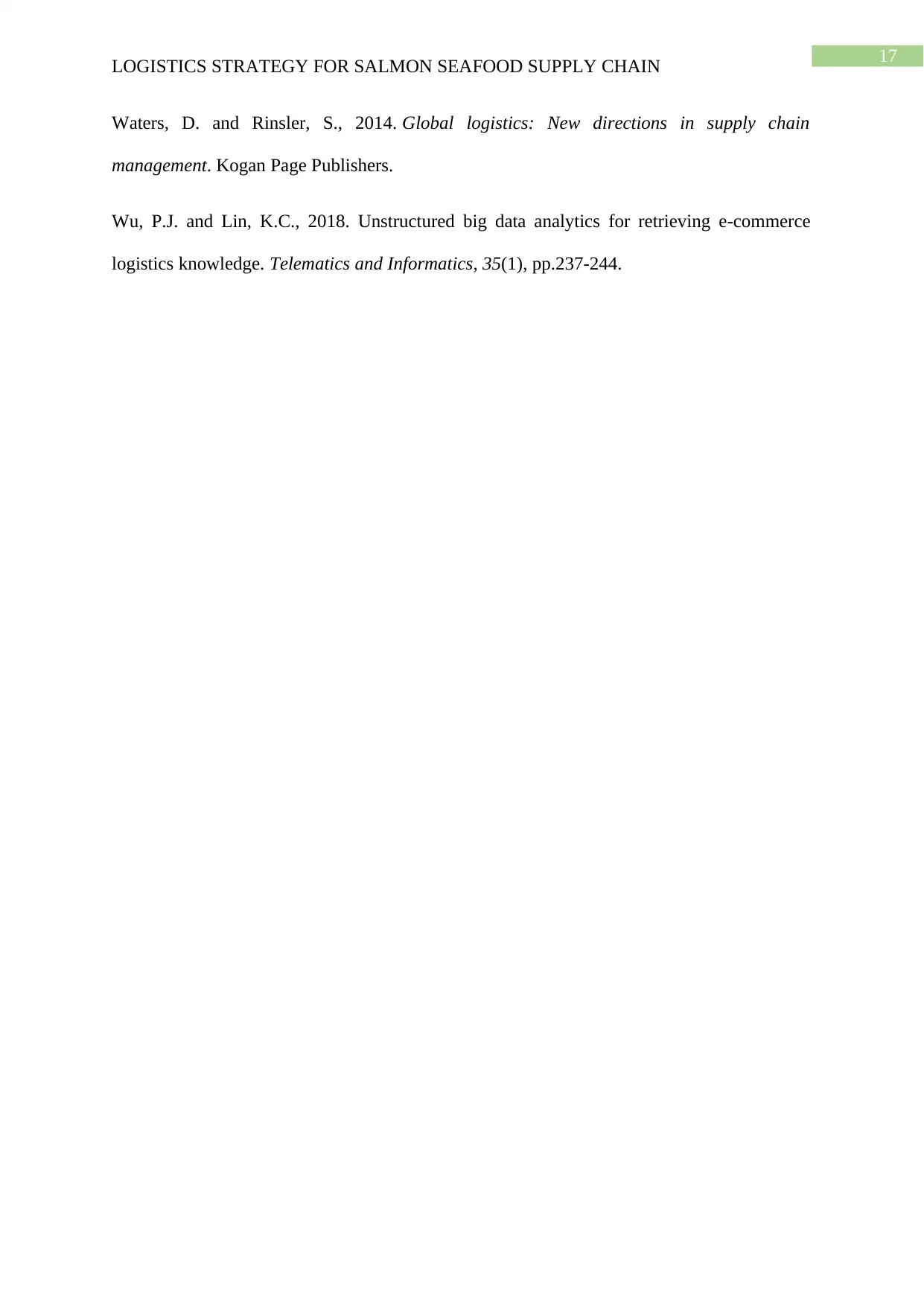
17
LOGISTICS STRATEGY FOR SALMON SEAFOOD SUPPLY CHAIN
Waters, D. and Rinsler, S., 2014. Global logistics: New directions in supply chain
management. Kogan Page Publishers.
Wu, P.J. and Lin, K.C., 2018. Unstructured big data analytics for retrieving e-commerce
logistics knowledge. Telematics and Informatics, 35(1), pp.237-244.
LOGISTICS STRATEGY FOR SALMON SEAFOOD SUPPLY CHAIN
Waters, D. and Rinsler, S., 2014. Global logistics: New directions in supply chain
management. Kogan Page Publishers.
Wu, P.J. and Lin, K.C., 2018. Unstructured big data analytics for retrieving e-commerce
logistics knowledge. Telematics and Informatics, 35(1), pp.237-244.
1 out of 18
Related Documents
Your All-in-One AI-Powered Toolkit for Academic Success.
+13062052269
info@desklib.com
Available 24*7 on WhatsApp / Email
![[object Object]](/_next/static/media/star-bottom.7253800d.svg)
Unlock your academic potential
© 2024 | Zucol Services PVT LTD | All rights reserved.





